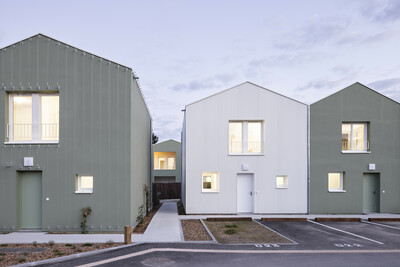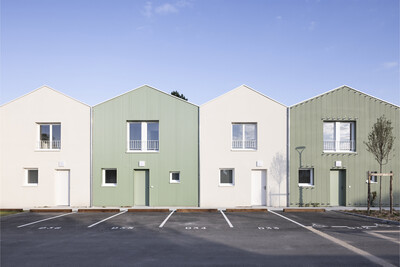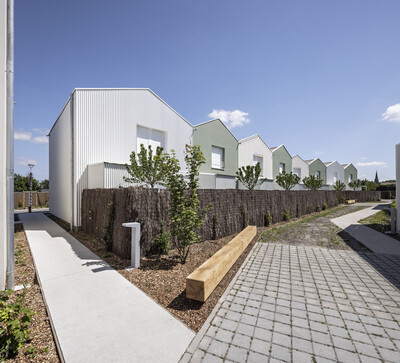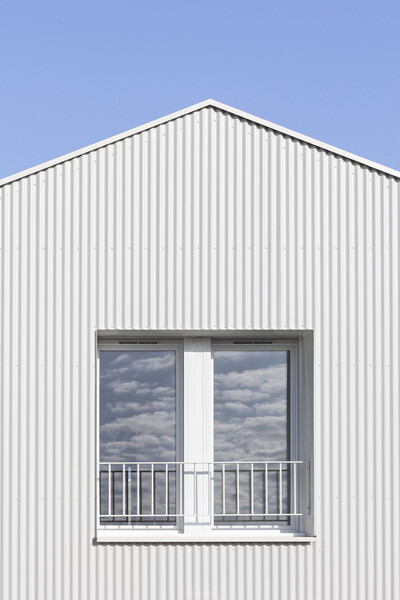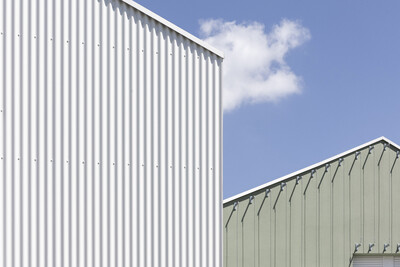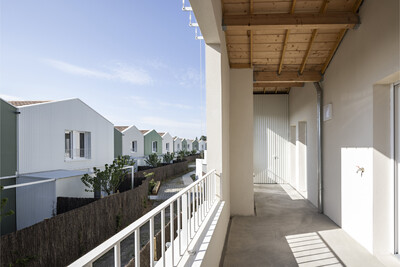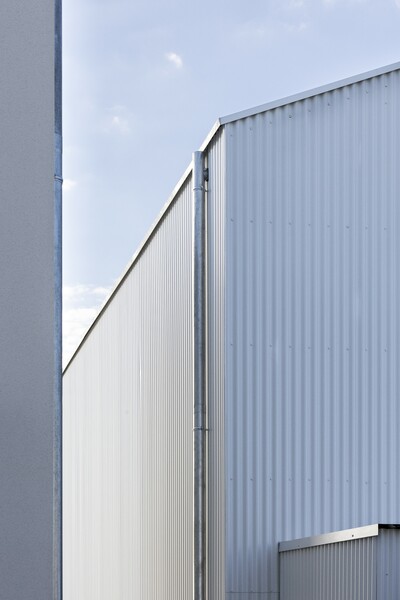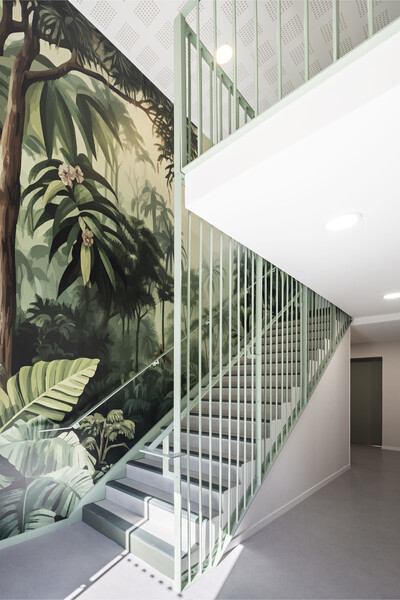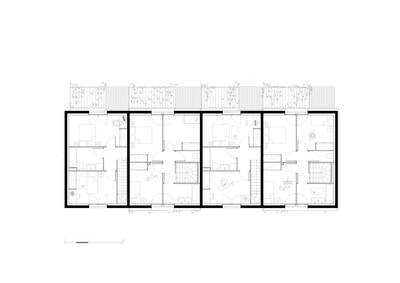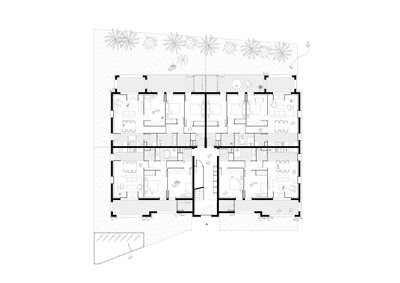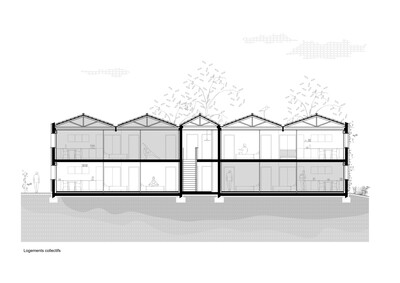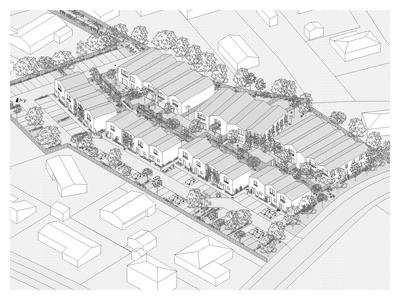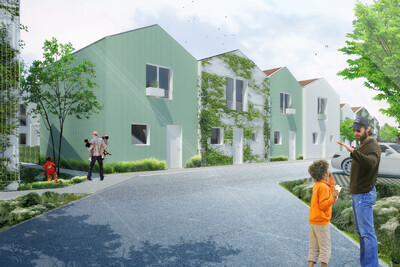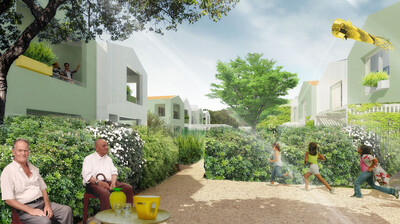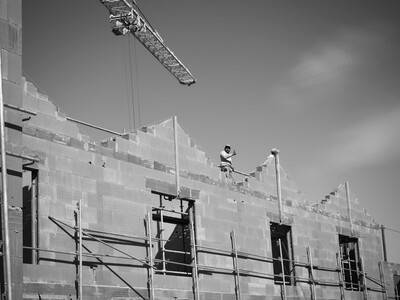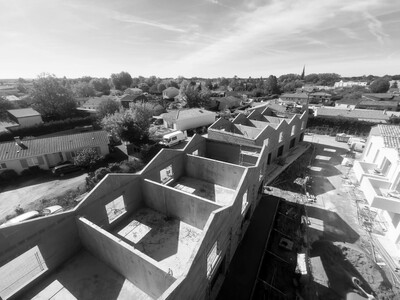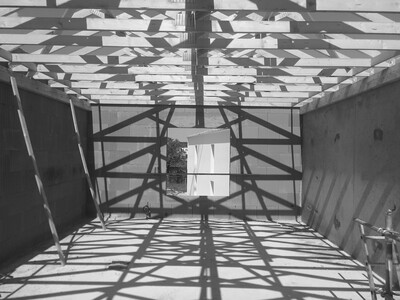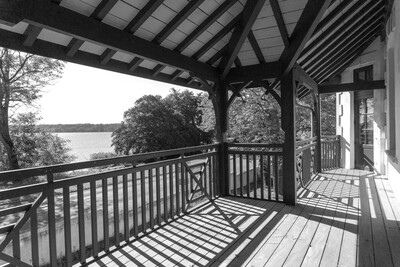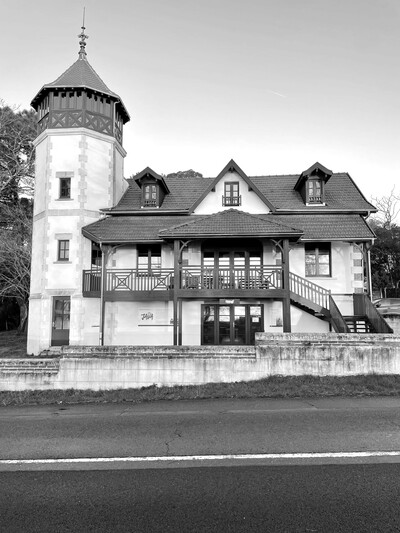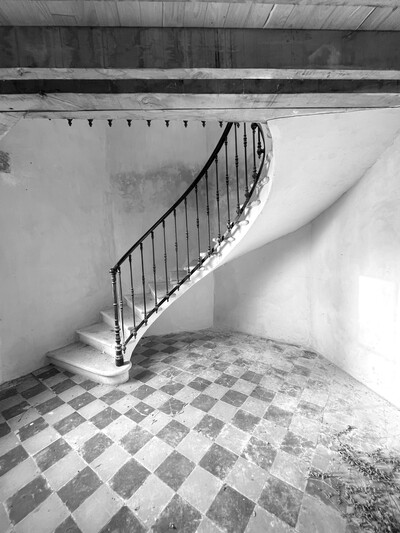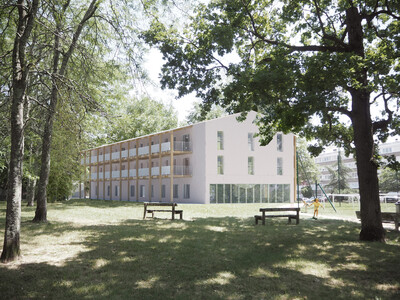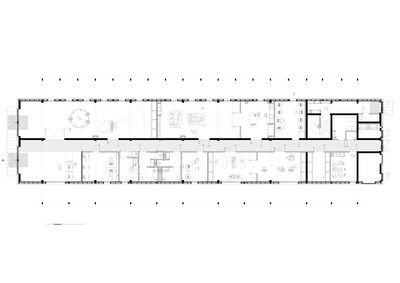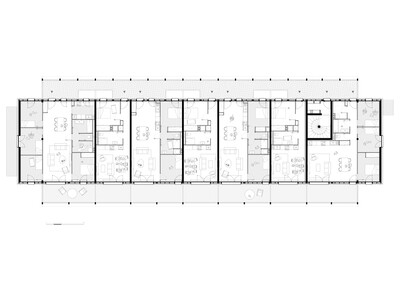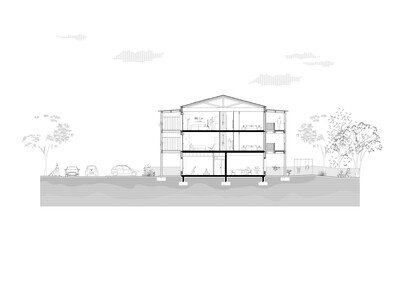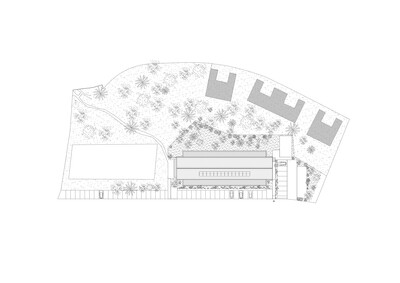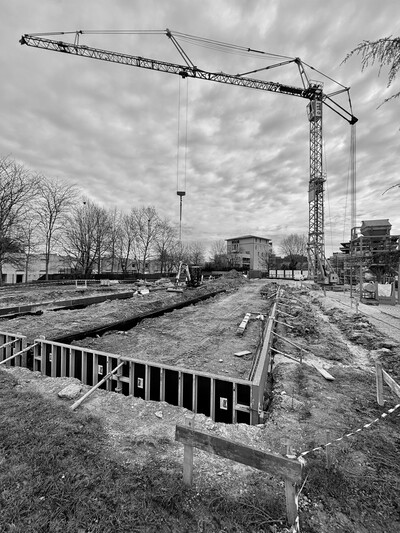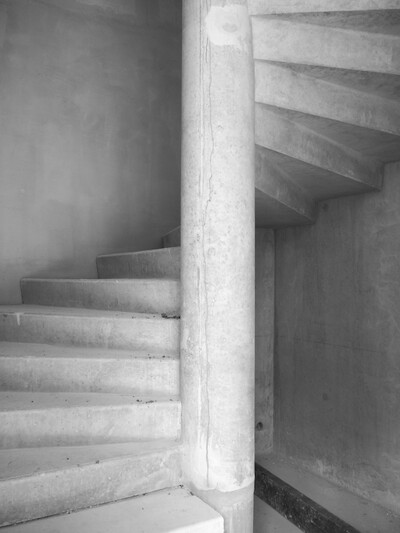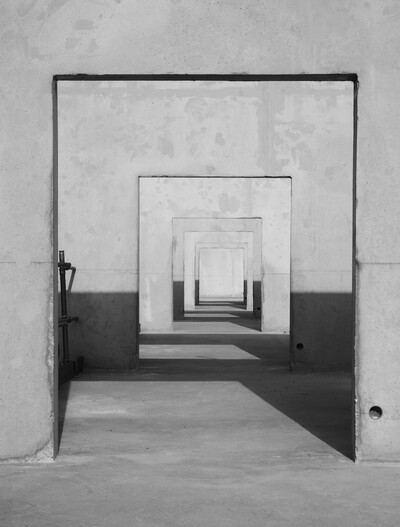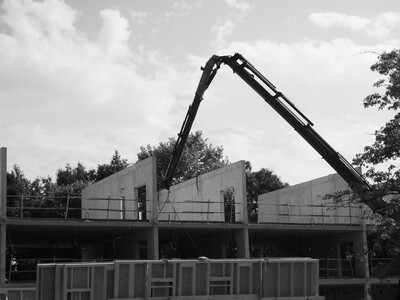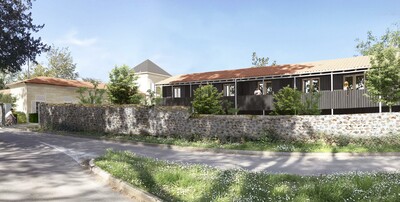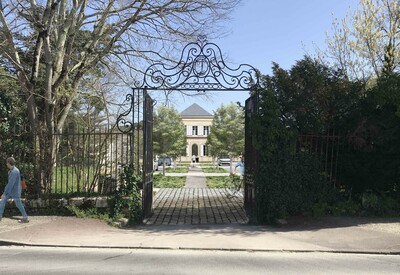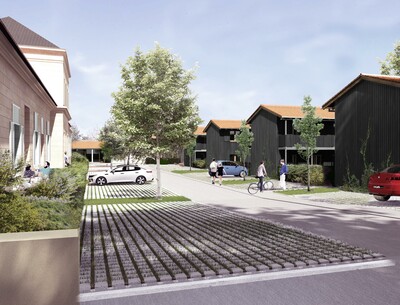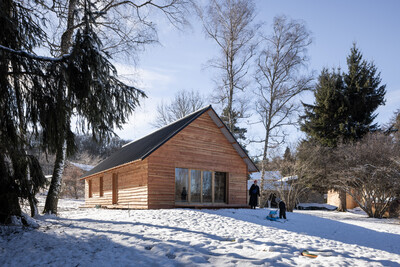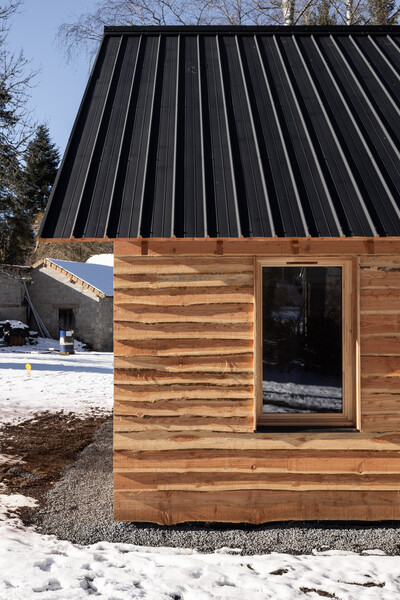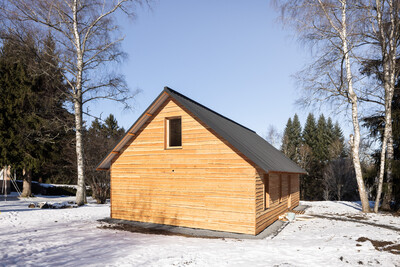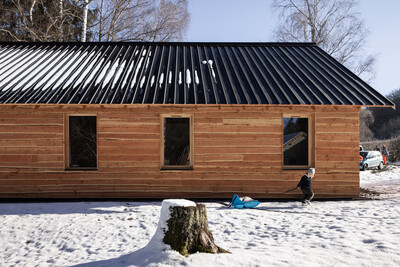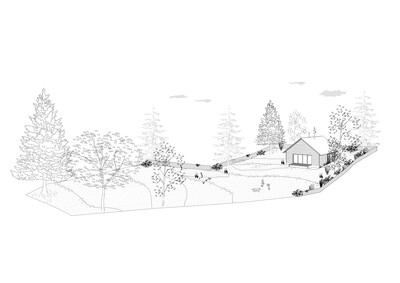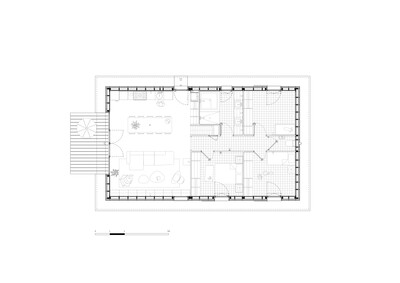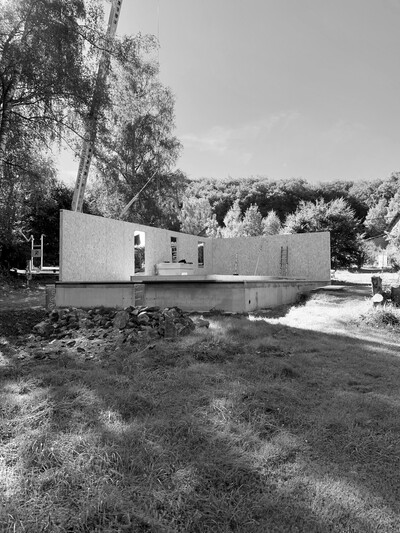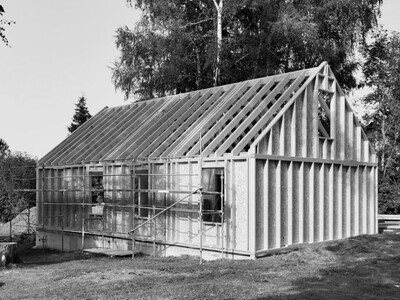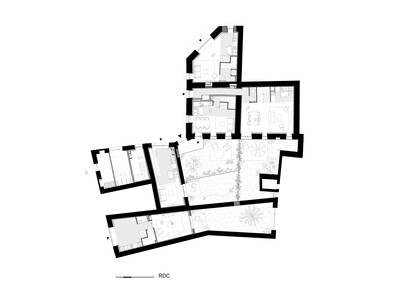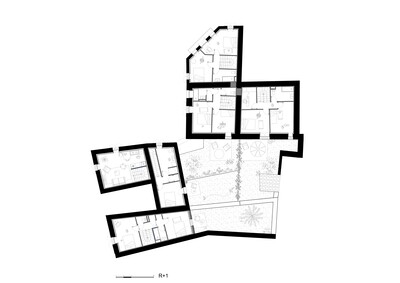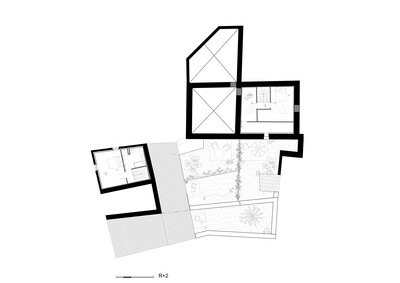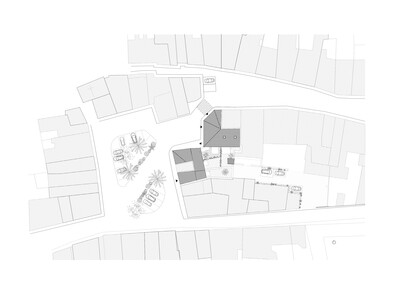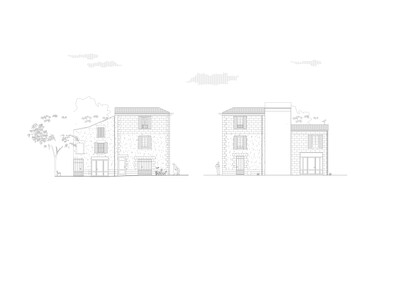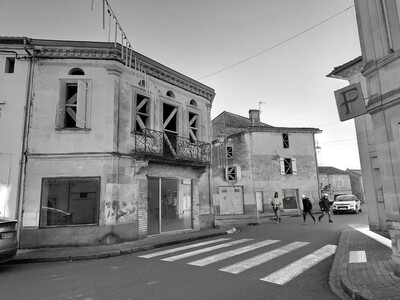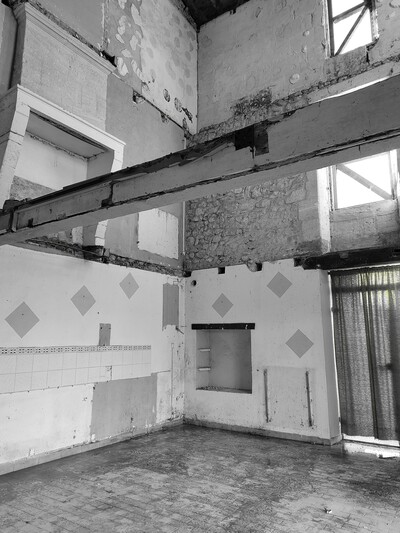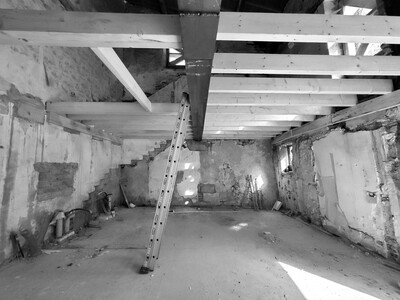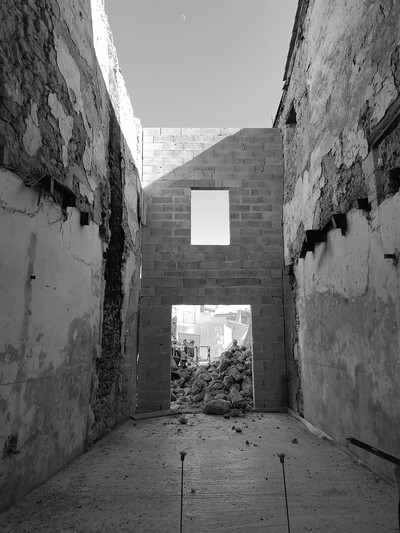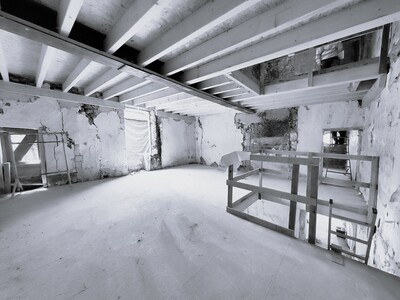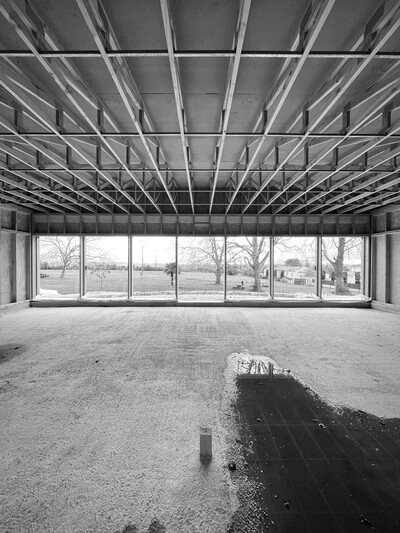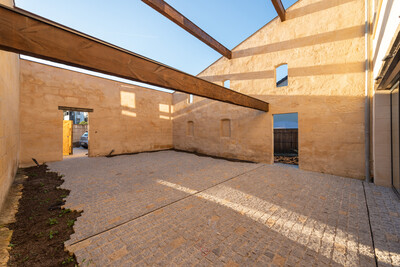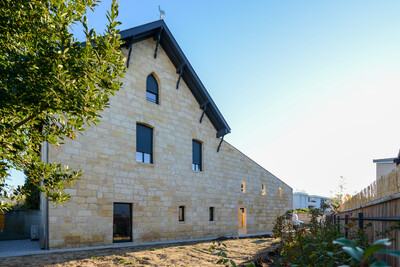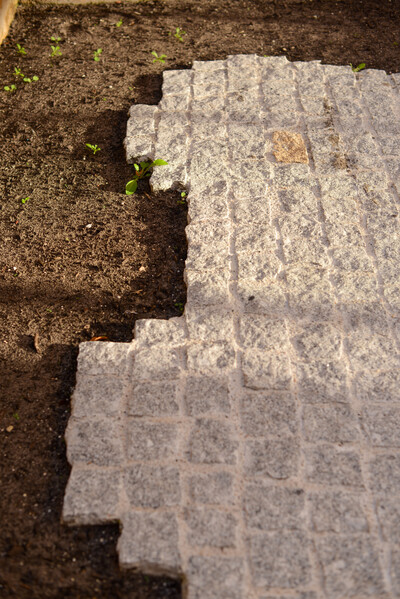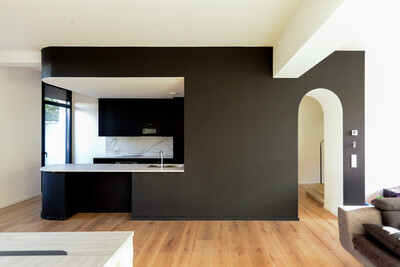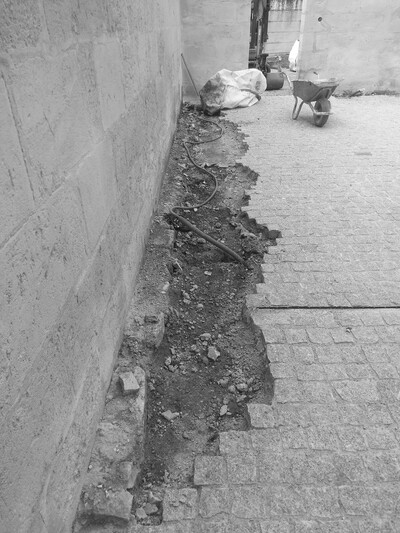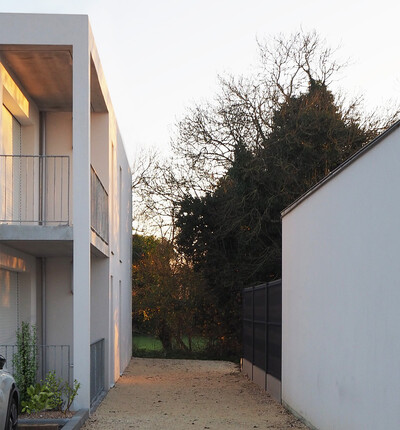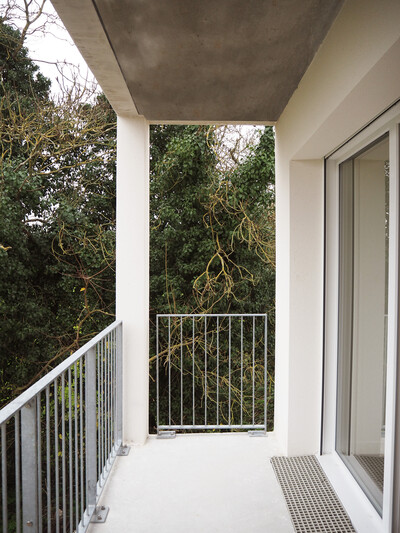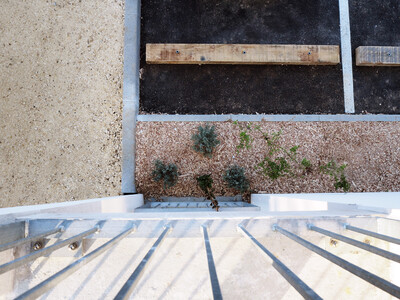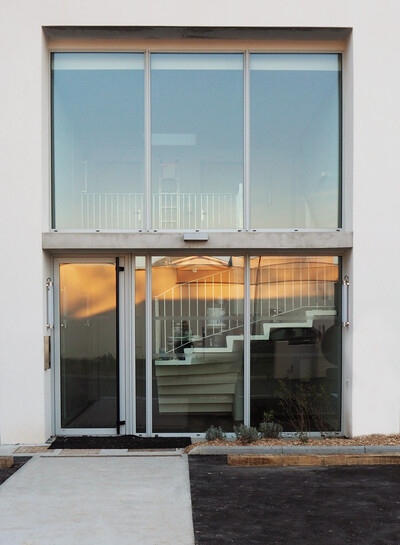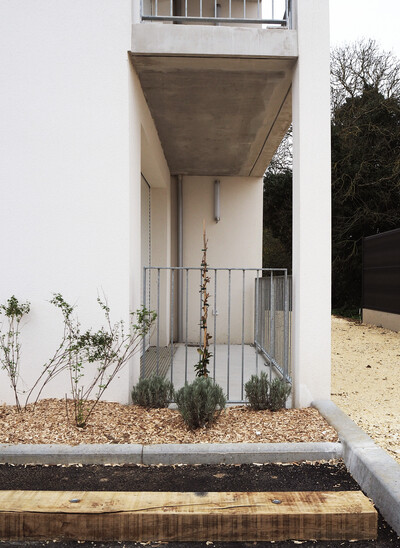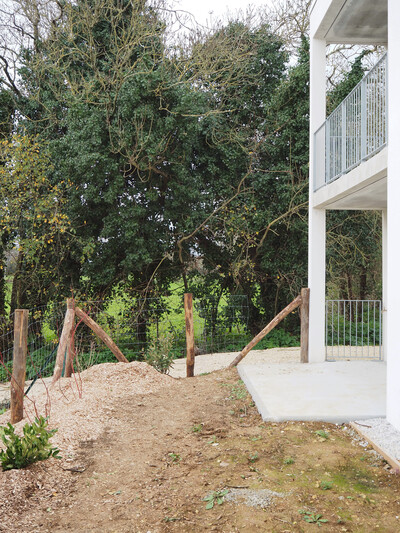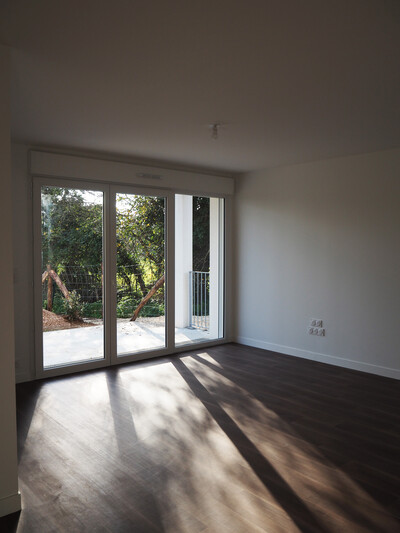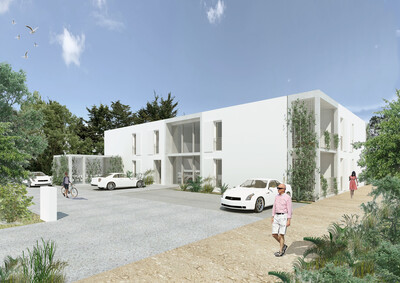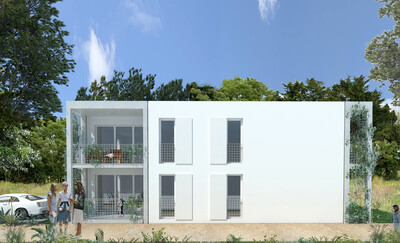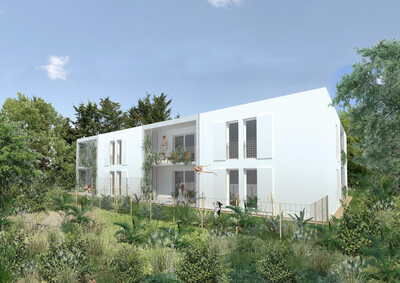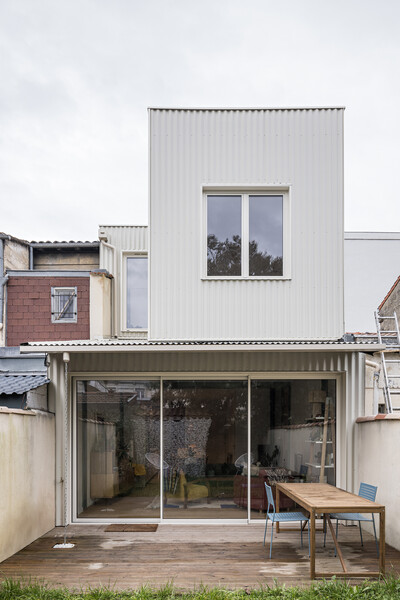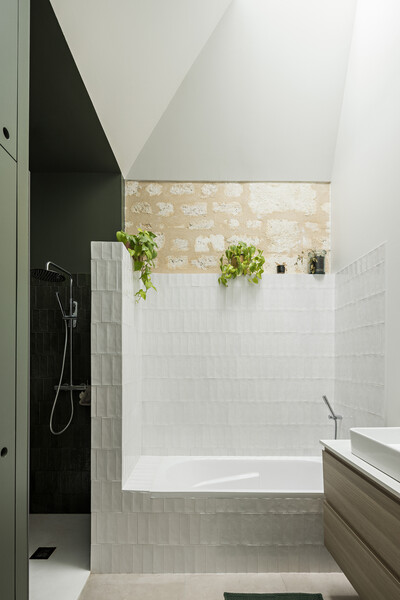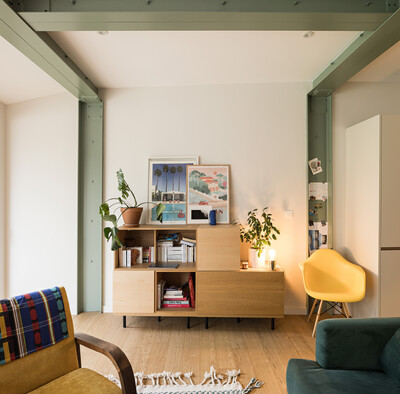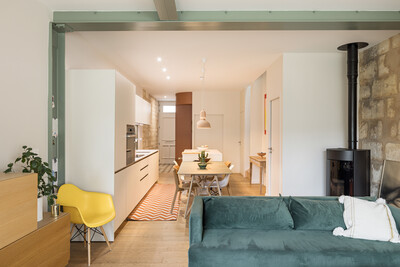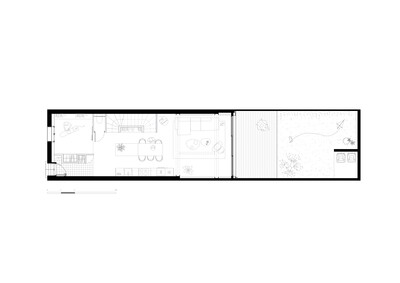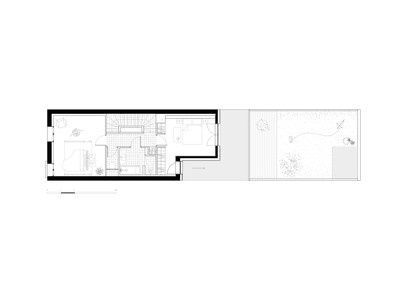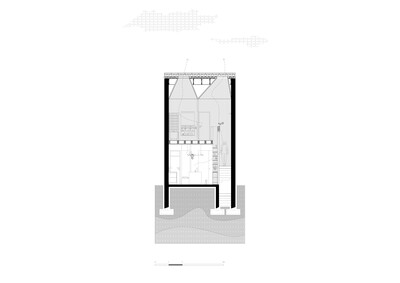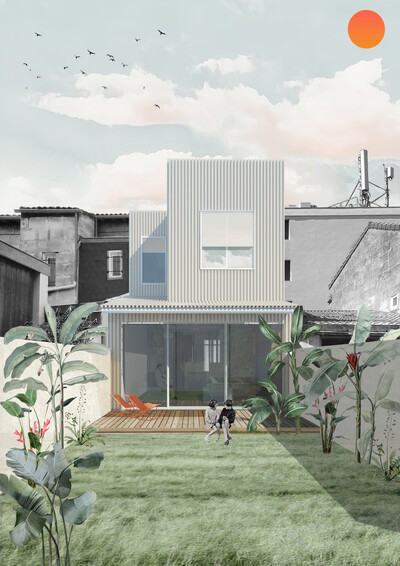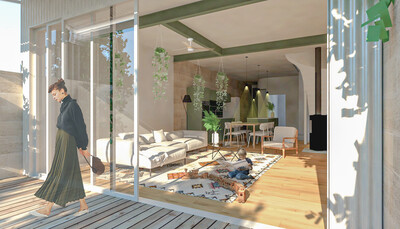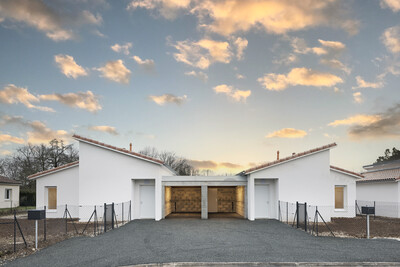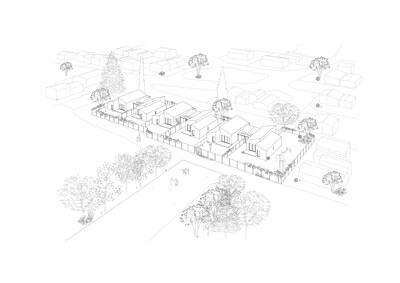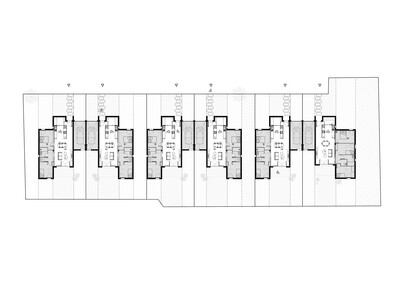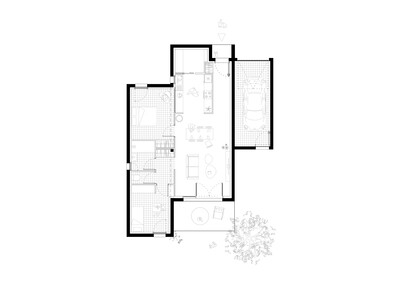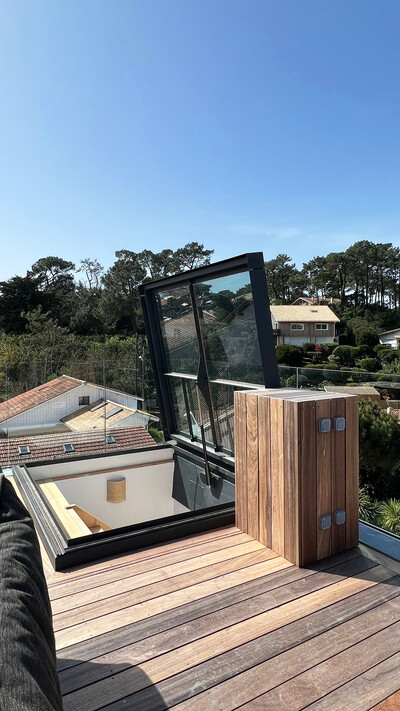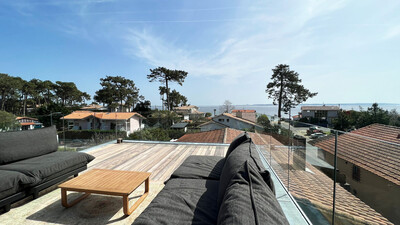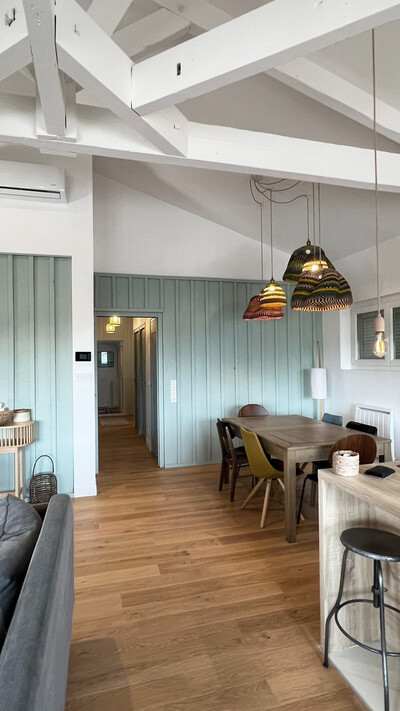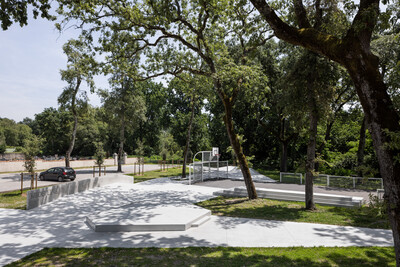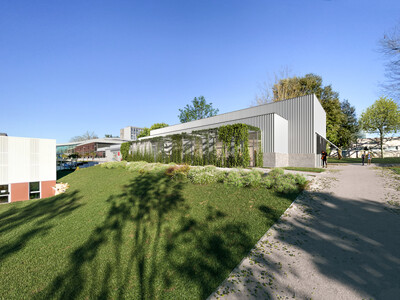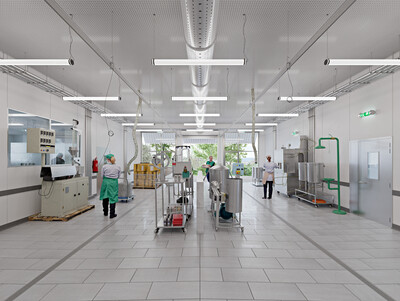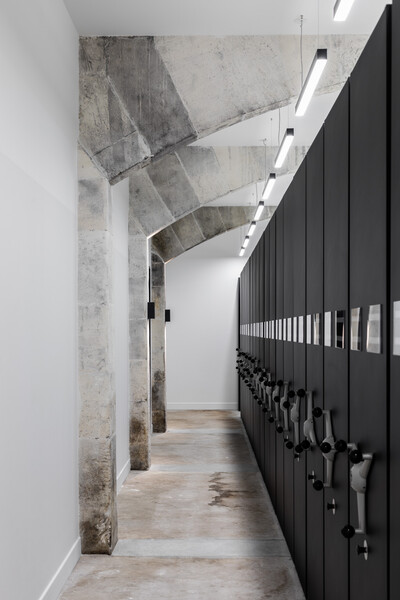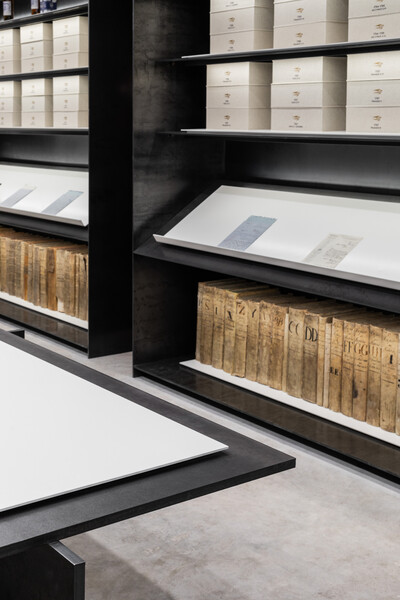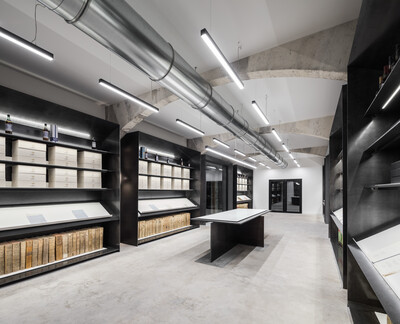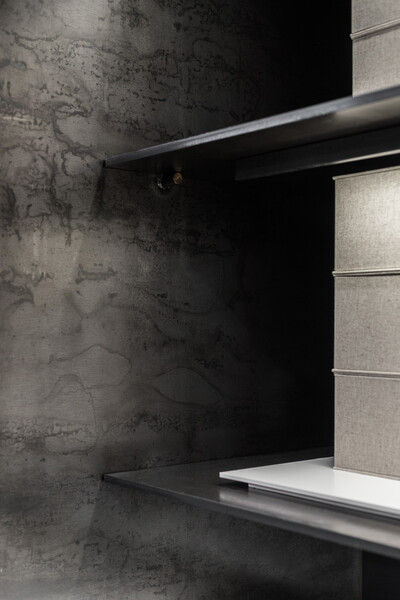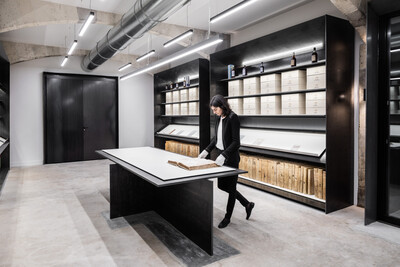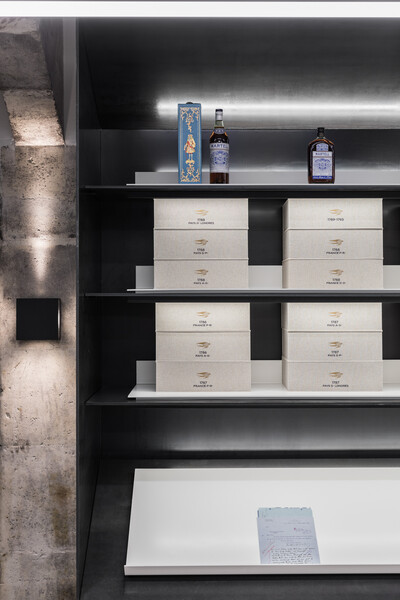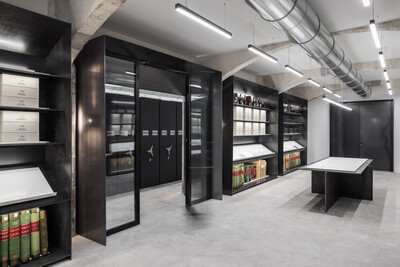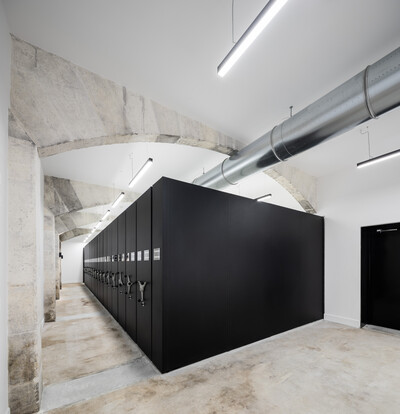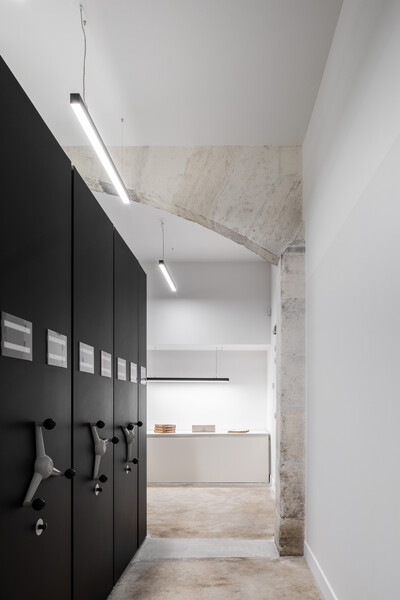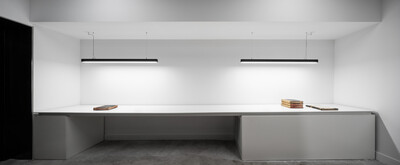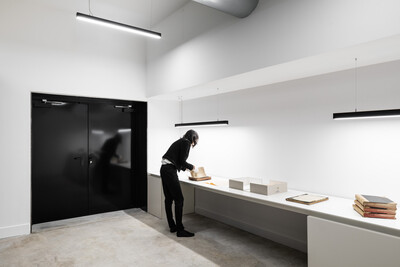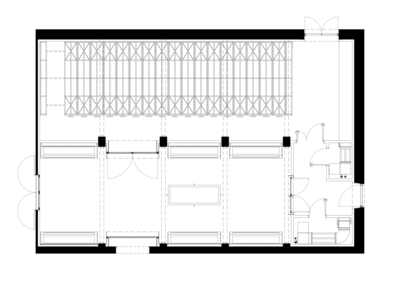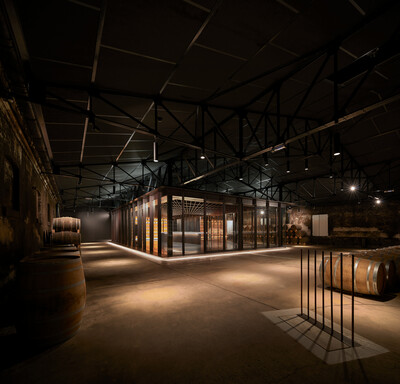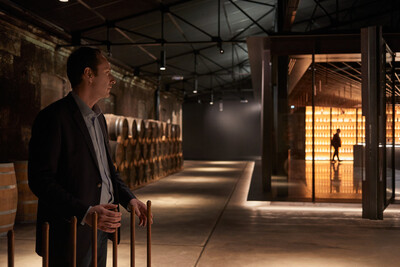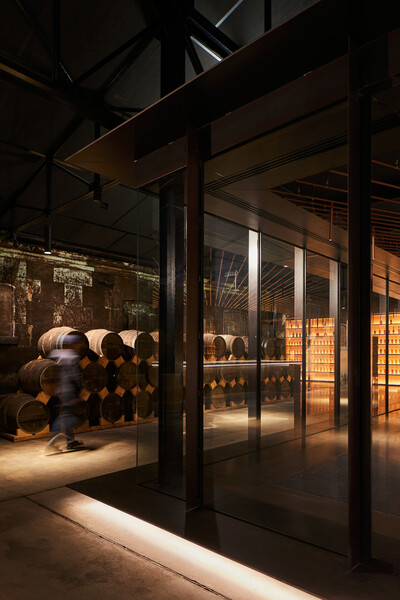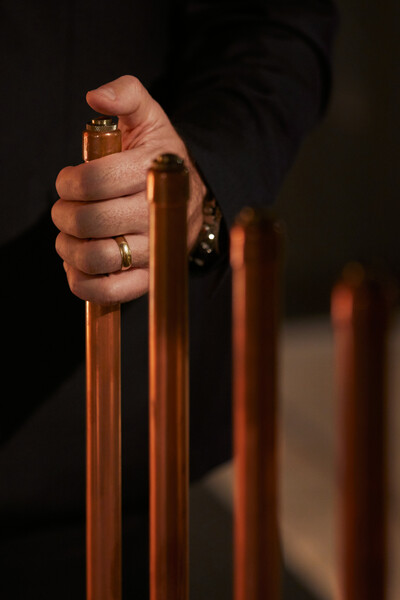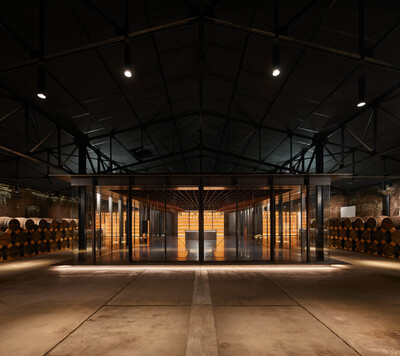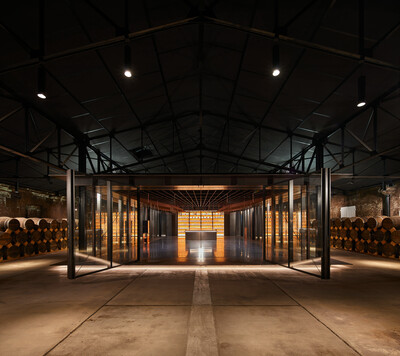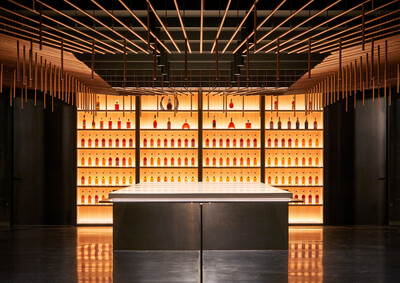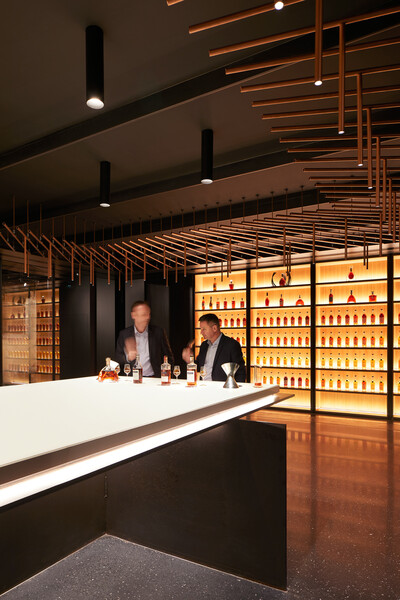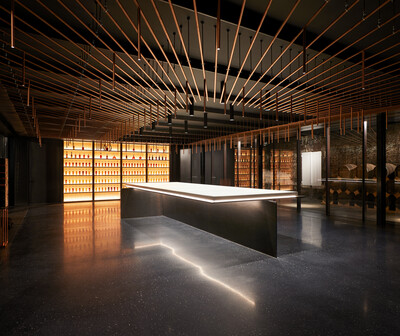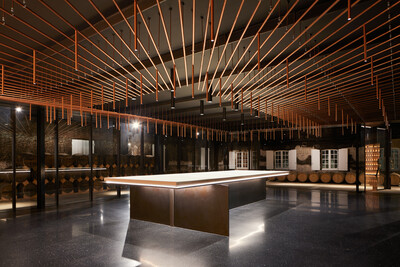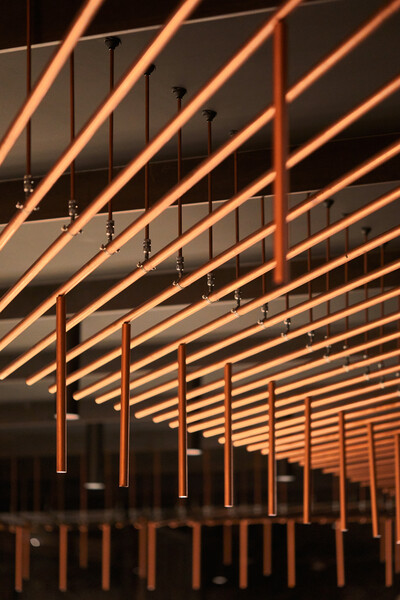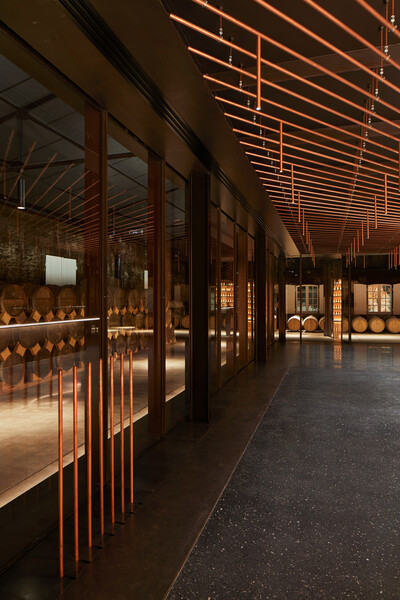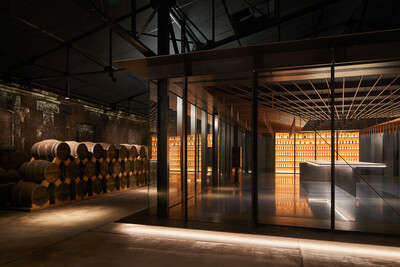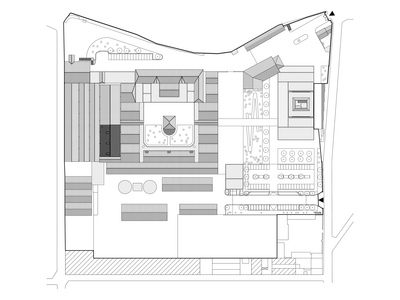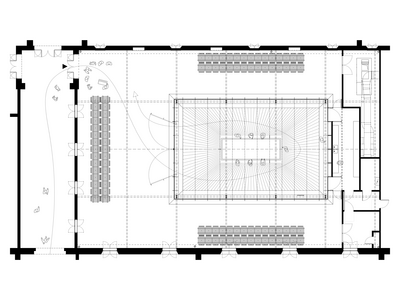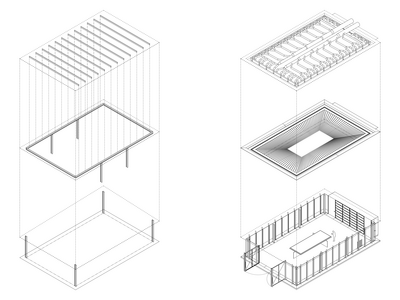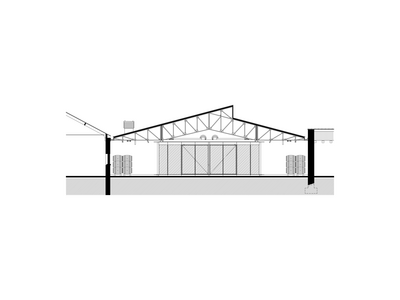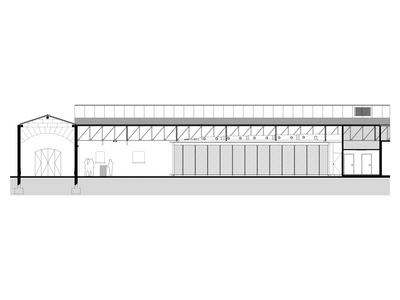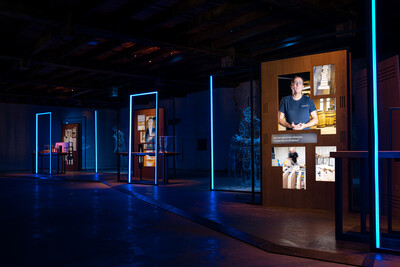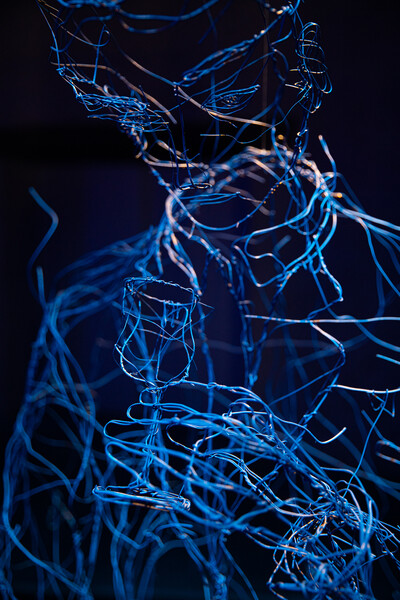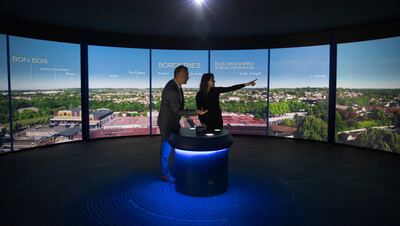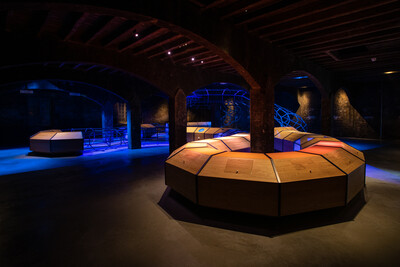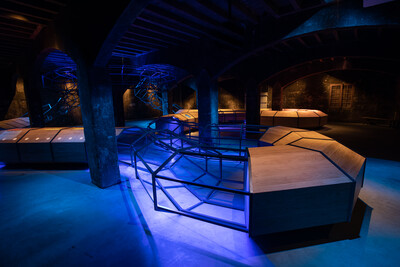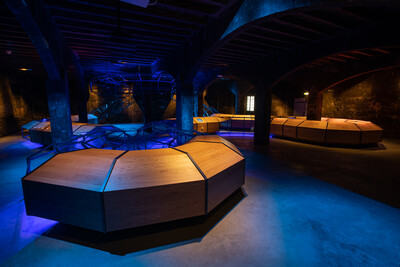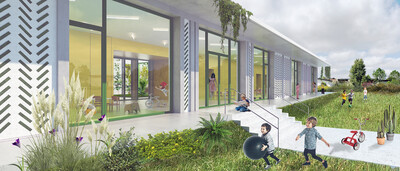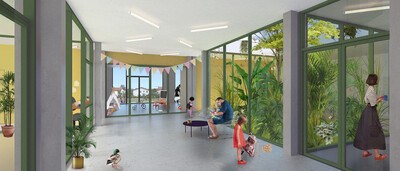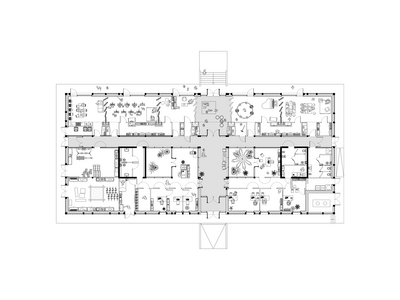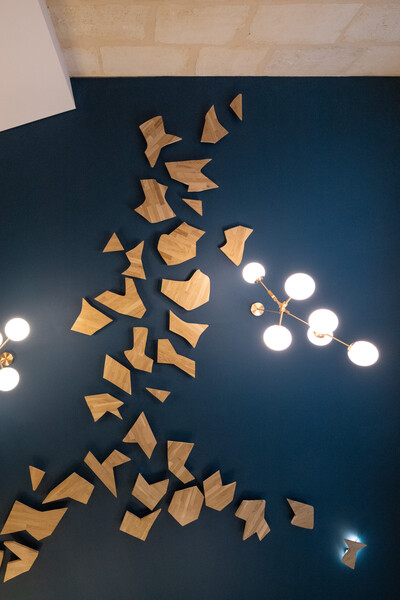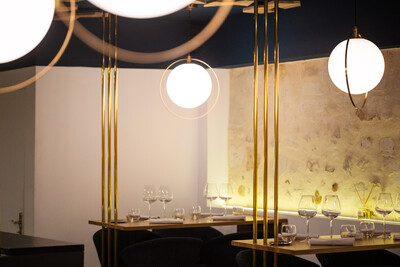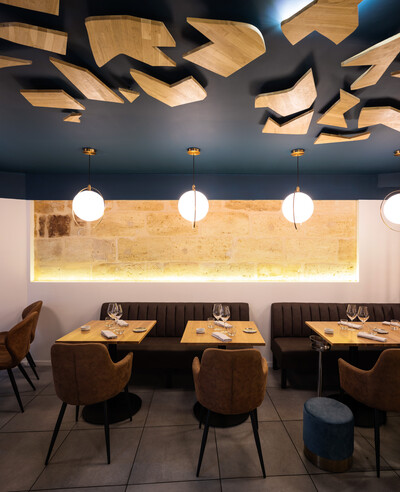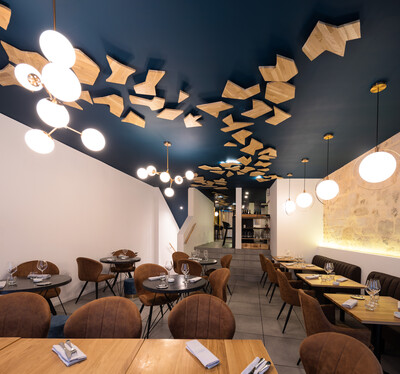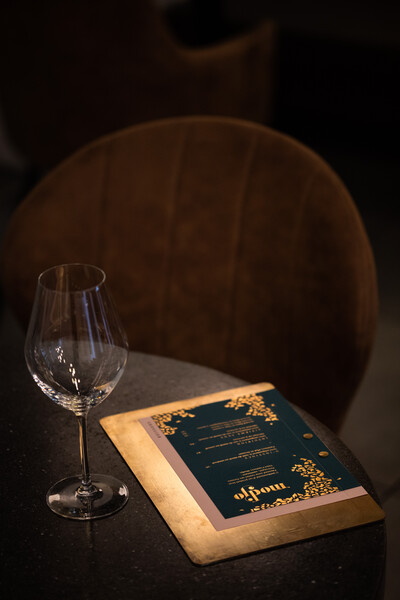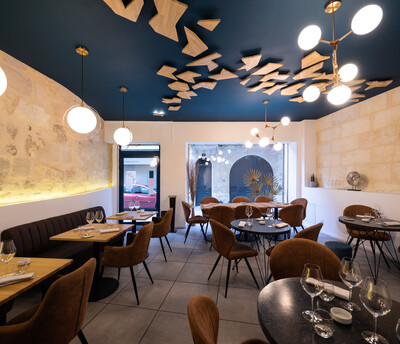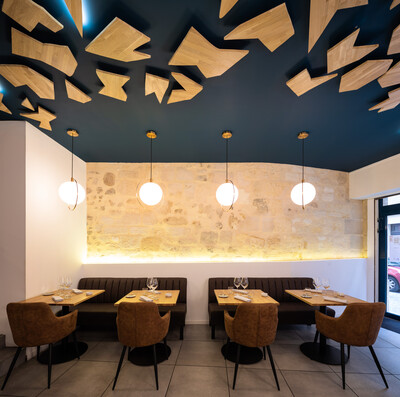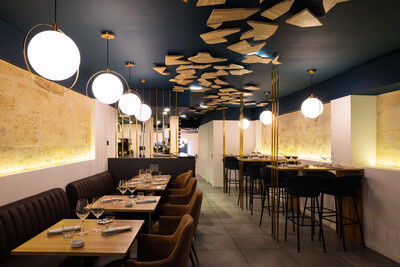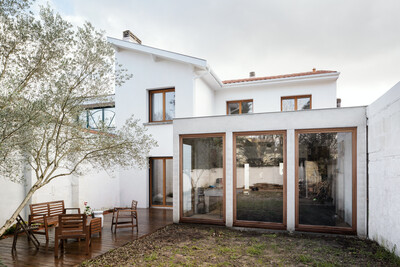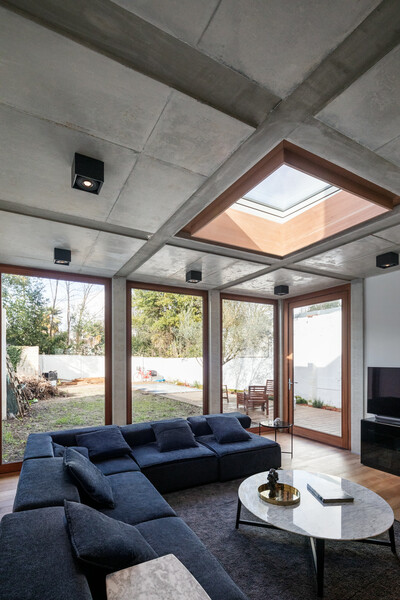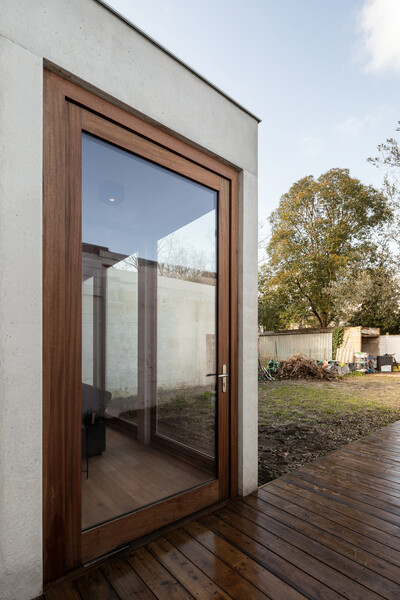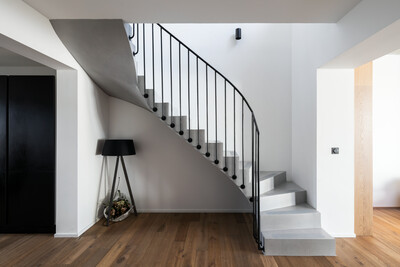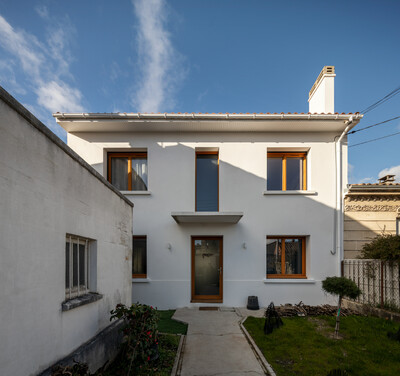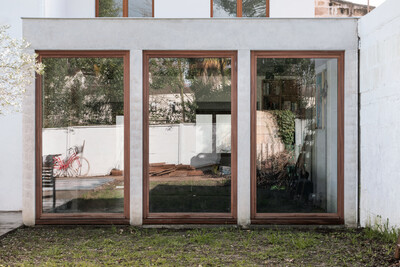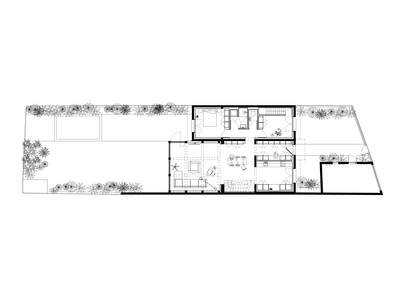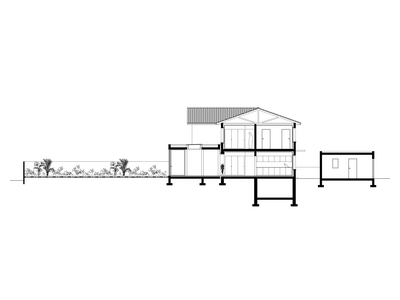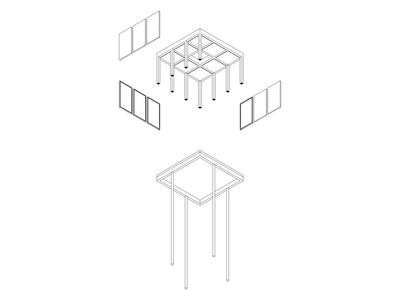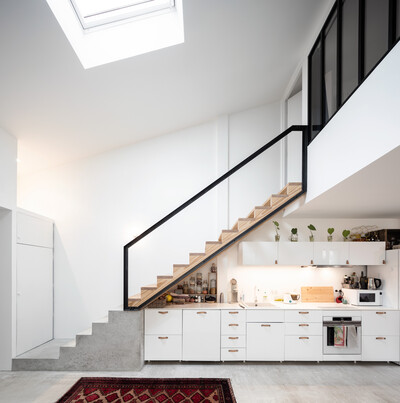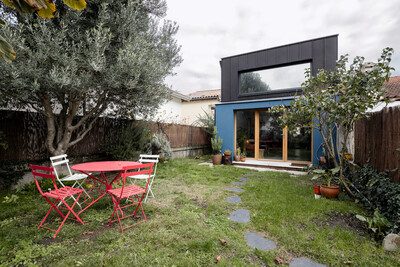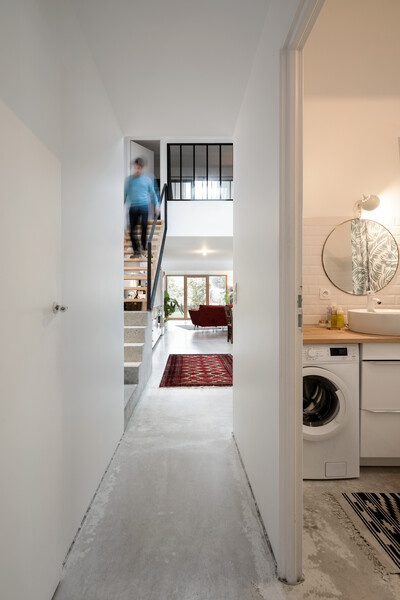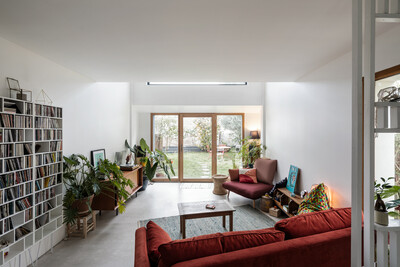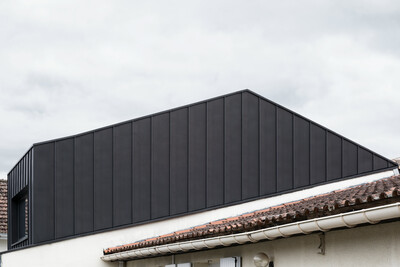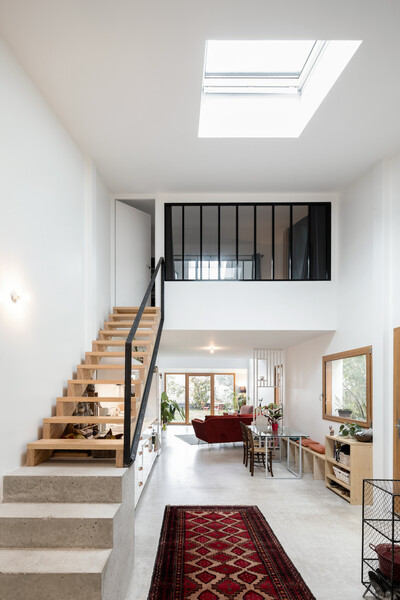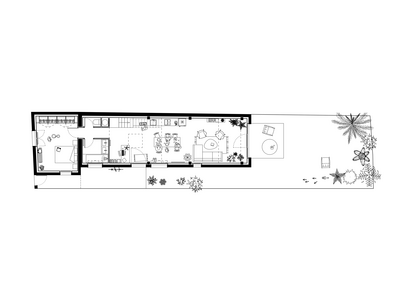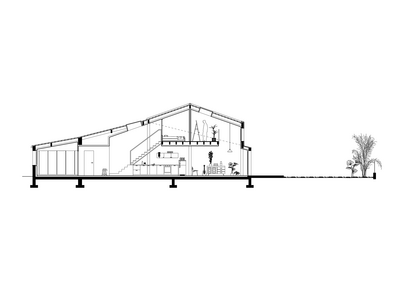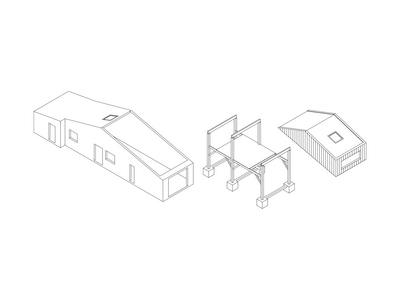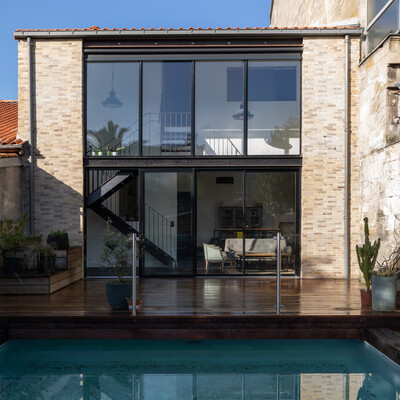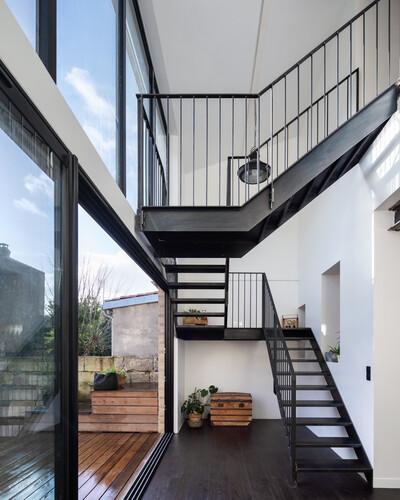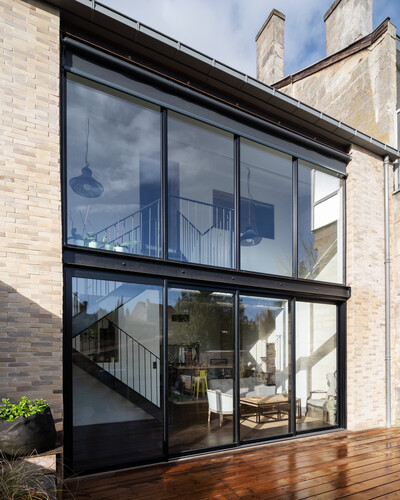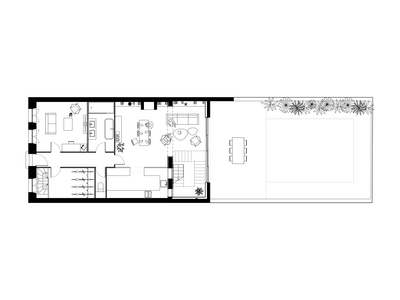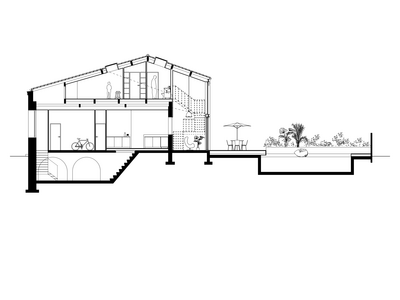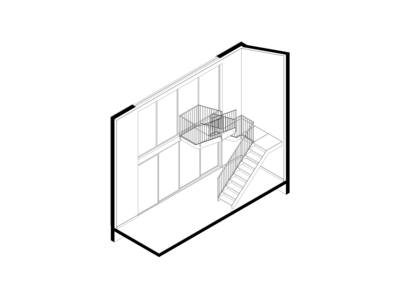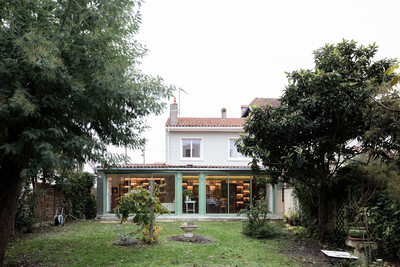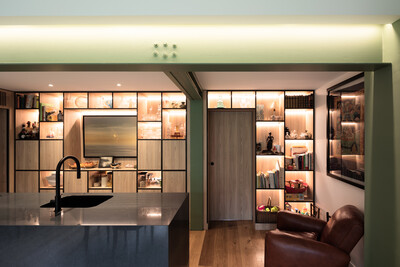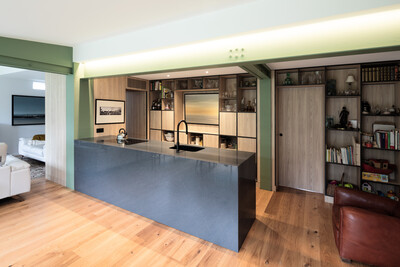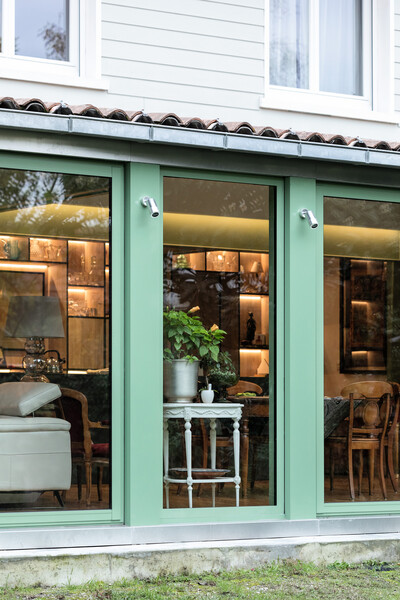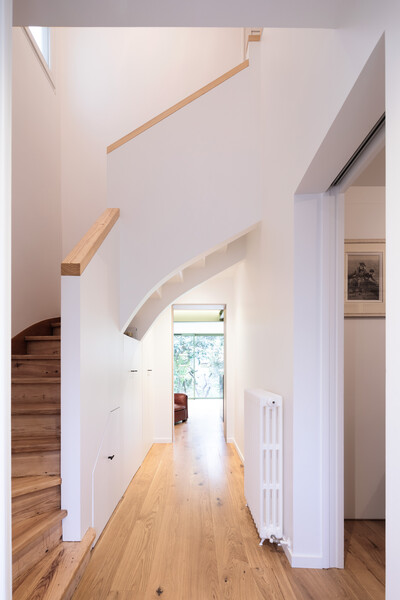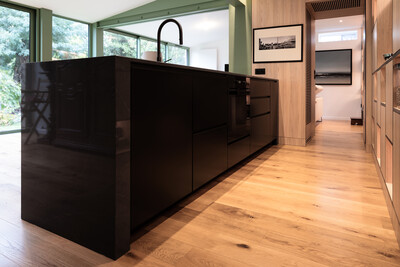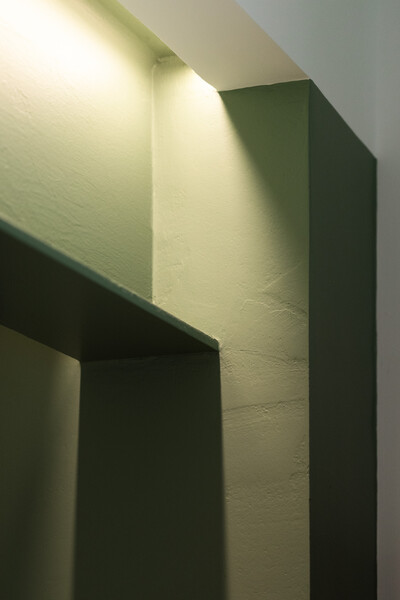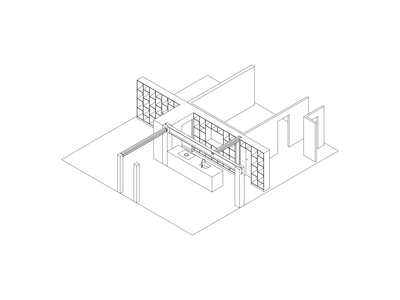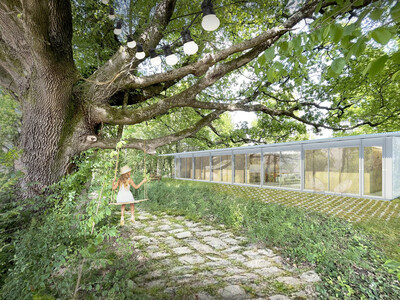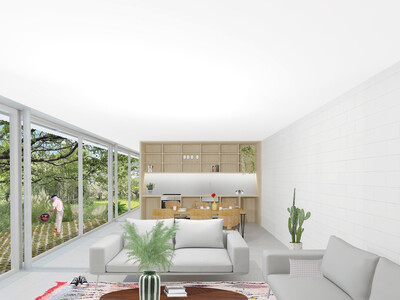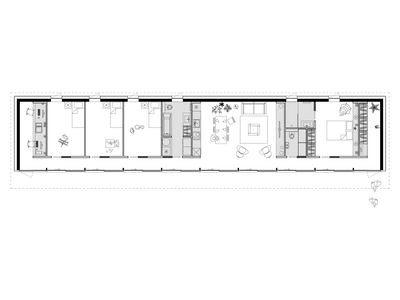Draw on the serial reproducibility of a social housing programme to create an urban habitat that incrementally densifies a low-rise suburban area.
Planning permission for 23 social housing units
The social housing rental company Domofrance would like to apply a planning permit in the suburban fabric of Parempuyre, a peripheral suburb of Bordeaux. The project for rental social housing is developed according to a principle of strips of housing. By questioning the urban form, working on various scenarios, fifteen individual houses grouped together and three apartment building establish a composition that respects the scale of the existing buildings and plays on a multiplicity of identities within a homogenous framework. An economy of means dictates the architectural work, which deploys standard elements while seeking to vary their effects. Micro shifts in positioning bring the overall plan to life, two windows combined create larger openings, while loggias allow for an array of solid constructions and empty spaces. The colorimetric variations of the facades and interplay of roofing styles provides the scale of a new neighbourhood while ensuring the density sought by the city council. The architecture is founded on system variations to provide a domestic scale in which vegetation and buildings enter into a conversation, in a reinterpretation of the typology of urban houses.
Un Centre social comme socle d’un projet hybride vertueux, composé de logements traversants en accession et s’inscrivant dans le parc d’un quartier moderne en évolution.
Construction de 14 logements et d’un centre social
Le projet s’inscrit dans un parc au Nord d’un quartier moderne faisant l’objet d’un projet de rénovation énergétique des bâtiments et de réaménagement paysagé du quartier. Le parc qui accueille le projet fera lui-même l’objet d’un projet paysagé mené par la Ville de Talence qui a acquis le foncier et qui sera directement lié au projet. Il sera composé d’un socle au rez-de-chaussée, occupé par un nouveau centre social géré par la Ville de Talence et de logements traversants en accession dans les étages. Les logements profiteront de larges terrasses en bois au sud. Le centre social profitera du parc qui s’ouvre à lui. L’ensemble est pensé et conçu comme un projet vertueux, construit avec des matériaux biosourcés et profitant de principes de ventilation naturelle.
Réhabilitation de la chartreuse en 15 logements et création de 24 logements dans le parc
Construction d’une maison en bois
Le projet se situe chemin des Dômes à Mazayes, dans un lieu-dit dans les forêts environnant le Puy de Dômes en Auvergne. Issu d’une division parcellaire, le terrain, en longueur, arboré, donne d’un côté sur la route principale du lieu-dit au Sud et s’ouvre sur le paysage et la Forêt au Nord. La future maison, viendra s’implanter entre les arbres et dans un souci d’optimiser l’orientation et de limiter les vis-à-vis avec les voisins. Le projet, qui se fera en plusieurs phases prévoit également l’implantation d’une future annexe pour les invités et une piscine naturelle. Dans un premier temps, le projet prévoira la construction de la maison, qui prendra la forme d’un chalet contemporain et adapté au climat local. La projet sera construit en bois, avec une forte présence de ce dernier, autant à l’intérieur qu’à l’extérieur. Le bois sera naturel à l’intérieur, apportant chaleur et confort. Les menuiseries extérieures seront également en bois. La maison est organisée en deux parties : une partie nuit représentant environ la moitié de la maison au Sud, et une partie jour, au Nord, largement ouverte sur le paysage. La partie jour est une grande pièce de vie, avec salon, salle à manger, cuisine, et une mezzanine au-dessus de cette dernière, offrant une double hauteur agréable, définissant la volumétrie de la toiture. A l’extérieur, la maison sera noire et se fondra dans le paysage à l’image des maisons des communes voisines construites en pierre de lave et couvertes d’ardoises.
Réhabilitation d’un ensemble de bâtiments anciens en pierre et protégés en cœur de bourg en six logement collectifs avec jardinets.
Réhabilitation de 6 logements
Le projet se situe place de la halle, au cœur du bourg de Rauzan, face au château, au loin, et aux petits commerces de proximités et de l’école. L’ensemble de bâtiments anciens en pierre qui servira de base au projet était autrefois un ensemble de logements et de granges donnant sur un jardin en cœur d’ilôt. Le projet vise à redonner une cohérence et une seconde vie à cette ensemble pour revitaliser le centre-bourg. Les logements seront pour la plupart des duplex avec pièces de vie au RDC et chambres en R+1. Les entrées dans les logements se feront depuis la rue tandis que des jardinets seront attenants à chaque logement. Une venelle piétonne permettra de traverser de part-et-d ’autre ce cœur d’ilot pour accéder aux stationnements d’un côté et à la place de la Halle de l’autre, donnant accès également au local vélos commun.
Construction d’une salle de théâtre pour le Lycée Bellevue
Située à Saintes, cette nouvelle salle de théâtre du Lycée Bellevue vise à remplacer l’ancien bâtiment, un préfabriqué en mauvais état peu adapté, par une nouvelle salle confortable et intégrée au paysage.
D’une conception moderne avec des principes fonctionnalistes, la salle peut accueillir 100 personnes et répond aux besoins spécifiques du théâtre. Elle est accessible à l’Ouest, par un SAS alimentant deux vestiaires et deux sanitaires. Le projet tire profit de son implantation et l’ensemble du programme s’inscrit dans un plan circulaire de 20m de diamètre, compact, traversant d’Ouest en Est. Deux préaux à l’Ouest et à l’Est permettent de contrôler les apports solaires et les flux de spectateurs. La forme ronde en plan et cylindrique à pan coupé en volume s’inspire de deux éléments : les oyats, graminées du milieu dunaire local, qui ont comme particularité d’avoir des feuilles se refermant sur elles-mêmes pour se protéger du climat extérieur et les kiosques à musique, qui sont de fines structures circulaires dans les parcs et jardin de nos villes, lieux de spectacles et de culture ouverts à tous. La structure en bois apparente participe visuellement à l’identité de la salle. A l’extérieur, le projet se pare de minimalisme avec un bardage métallique réfléchissant le paysage et avec une ondulation rappelant un drapé de rideau qui flotterait dans le paysage. Le projet suit une logique biomimétique qui s’applique selon trois axes : le rapport étroit du bâtiment et des usagers à la nature ; la polyvalence et la réversibilité des usages ; la logique constructive Low-Tech utilisant des matériaux biosourcés.
Rénovation d’une maison en pierre de taille
Un paysagiste à la retraite décide de redonner vie à sa maison d’enfance. Le futur logement qui sera destiné à de la location de standing, impose de repenser une bâtisse en pierre de taille remplie de souvenirs. L’intérieur est sombre, partitionné et orienté essentiellement en façade Nord et Est ; l’extérieur conserve un jardin conséquent. Retrouver luminosité, intimité et spatialité forme le cahier des charges de la rénovation. Le chai qui occupait la moitié de l’emprise au sol est démoli afin de se transformer en patio paysager. Une nouvelle façade est générée et permet alors d’inonder le projet de lumière. Le rez-de-chaussée est transformé en grande pièce de vie filant vers cet oasis de fraîcheur. La cuisine s’habille d’arrondis pour adoucir cette rénovation contemporaine.
La création d’un escalier béton dans la continuité de celui en pierre permet de desservir un nouvel étage sous les combles : espace flexible pouvant accueillir tout aussi bien un espace de bureau qu’ une suite parentale.
Il s’agit d’une rénovation complète où seuls les murs, la charpente et la girouette emblématique seront conservés et sublimés.
Construction de 8 logements collectifs
Le projet se situe dans le lotissement «Les Amandiers» à Dompierre-Sur-Mer sur un terrain bordé par une haie protégée, deux bassins de rétention et un chemin rural emprunté occasionnellement par quelques promeneurs. Sa localisation en retrait des autres constructions du lotissement, principalement des maisons individuelles de style traditionnel, fait qu’il se démarque par sa comptemporanéité. Son implantation au cœur d’une végétation dense et haute permet de faire rayonner les vues du projet aux quatre points cardinaux sur l’écrin de verdure environnant. Le bâtiment de 8 logements, compact, en R+1, est très horizontal, une caractéristique contrebalancée par la démarcation matérielle des loggias. Pensées comme des jardins suspendus en béton brut, serrureries légères et couvertes de plantes grimpantes, elles contrastent matériellement avec le blanc immaculé du volume principal.
Réhabilitation d’une maison individuelle
Construction de six maisons individuelles et garages avec un fonctionnement en bandes permettant d’apporter de la densité tout en préservant l’intimité des habitants.
Six maisons dont cinq T3 et un T4
Le terrain se situe dans un quartier pavillonnaire du Pizou et accueillait jusqu’à sa démolition en 2016 un bâtiment de 24 logements collectifs. La parcelle est bordée à l’ouest par un terrain de football et un boulodrome, au nord, à l’est et au sud par des maisons individuelles. Les toitures de cette architecture locale sont majoritairement à deux pans et leurs différentes hauteurs apportent des variations et du rythme à l’ensemble. Les matérialités sont traduites par des tuiles romanes en toiture et des façades enduites en teintes claires. Quelques arbres sont présents sur la parcelle, des cyprès et un sapin. Les six maisons de plain-pied (5 T3 et 1 T4) sont disposées via un système de logements en bandes permettant à la fois une certaine densité tout en limitant les vis-à-vis. Les maisons fonctionnent par deux et sont accolées par le garage. Chacune profite d’un jardin et d’une terrasse orientés sud-ouest. Les cinq T3 sont disposés à gauche et le T4 à droite, profitant ainsi d’un plus grand jardin. Chaque logement est composé de trois bandes (garage - pièces de vie - pièces de nuit et d’eau). A l’intérieur, une entrée avec placard dessert le séjour. La cuisine communique avec la pièce de vie et donne accès à la buanderie via une porte coulissante. Le séjour est systématiquement prolongé par une terrasse de 10m² accessible via une large baie vitrée. La bande pièce de vie dessert via un dégagement la bande pièces de nuit et d’eau, optimisée afin de limiter au maximum l’espace de circulation. La volumétrie est à l’échelle de ce quartier où les bandes pièces de vie et de nuit sont surplombées d’une toiture à 1 pan dont les hauteurs varient légèrement à l’image des constructions environnantes. Les garages sont quant à eux en structure légère et toiture plate type bac acier. Cette succession de volumes apporte une dynamique et un rythme à l’ensemble
Réhabilitation d’une maison et création d’une terrasse sur le toit
Construction d’une promenade skatable
La promenade skatable se situe à Mios, sous des chênes centenaires et valorise le site en lui conférant un véritable statut de parc. Les cheminements connectent les équipements existants, l’église, le groupe scolaire, le city-stade, les jeux pour enfants, le futur parking du cimetière. Réalisé en béton il est ponctué de bancs, de mouvements de sols, d’un gradin, d’un muret affichant le nom du lieu, et d’un kiosque propice à la tenue de petits concerts. L’ensemble est conçu pour les promeneurs mais aussi pour la pratique des sports de glisse. Plus qu’un skatepark, il s’agit d’un lieu public mixte et intergénérationnel ayant vocation à dynamiser l’activité du centre ville. Les évolutions climatiques nous ont conduit à concevoir un skatepark réduisant les surfaces imperméabilisées pour permettre un usage plus agréable durant les période estivales, tout en respectant le site et sa biodiversité.
Construction d’une halle technologique sur le Campus Périgord
After the chiaroscuro of the chais (spirits storehouses), the white lacquer of the archives plays on bold contrasts with the calamine of steel, the inox of the encasements, and the black of the shelves. Modernity is placed right up against the heritage elements.
Historical Archive
For the past three hundred years, Martell has conserved commercial registers, old books, bottles, and works of art. To showcase this legacy, two archival areas are installed within a former chai located along the discovery visit. Visitors are pleasantly surprised by the lighting activated by their presence, staged behind a window. They then access the display room, with its six bookshelves niched between stone vaults. At the centre, the archivist presents the precious documents on a long calamine-on-steel table, coated with white thermo-lacquered steel. This principle assumes a folded form on the steel shelves of the bookshelves: slightly detached shelf-covers protect the calamine from the handling of Cauchard boxes and leather compendiums. The curve of the underside of the bookshelves recalls that of the sandblasted vaults, reflecting the light right down to the exposed concrete floor. In the background, the conservation area is inaccessible, keeping the contents of its mobile shelves a mystery. The stark white lighting is even more distinctive. The technical details are cleverly concealed. The air from the extraction unit on the ceiling is sucked through the double-framed door of the machine room and the structural supports in the basement (each bookshelf weighs 2.5 tonnes) remain invisible. Collaboration after collaboration, a vocabulary and its spatial codes variously unfold to strengthen the architectural identity of the brand.
Creating a prestigious space for the assemblage of industrial materials as part of a pathway revealing the knowledge and expertise, magic and rituals of a renowned house of cognac.
Tasting room for master blenders
Martell wishes to showcase its three-hundred-year history and expertise through a tasting room where master blenders will work in front of an informed audience. A wine and spirits storehouse accommodates the project, an architectural setting with a strong identity: floor in rough concrete, thick walls covered in black mushrooms (torulas), a thin metal framework, with copper stills and oak barrels stored on site. In the centre of the space, the new tasting room skims the steel structure, nestled between four existing posts, and set slightly above the floor. The project is designed as an assemblage of materials, echoing the craftsmanship of the cellar masters who compose the vintages. Its minimalist silhouette takes advantage of the low lighting and silence, well suited to the ritual character of tasting. Two monumental doors welcome the visitors within the thirty-one-tonne structure in raw steel, coated with calamine. The cellar masters reveal their art and explain the menu of vintages set into a tasting table made of balanced layers of sheet steel, with a matte white surface on top to enhance the amber hues of the cognac that are also reflected in a copper chandelier. The work on the lighting reinforces the impact of the architecture, designed as an initiatory pathway: showcasing the roughness of the walls, unveiling the barrels, the room, and then the oak cognac library, as a backdrop.
Martell The Journey: a multi-sensorial and immersive visit experience to discover the house of cognac on its historic site of Gâtebourse.
Construction of Martell’s permanent exhibition visit
Aline Aubert
Edgar has provided the project management of technical lots for the permanent exhibition visit of the Martell House in Cognac, assisting and advising the scenographer, Nathalie Crinière. Designed prior to their intervention, three pathways are provided: ‘Heritage’ visits the archives, history, and development of the House of Cognac since its foundation by Jean Martell in 1715; ‘Expertise’ sets out to discover some of the experts who create the spirits (coopers, chai masters, farmers, etc.); and ‘The Angels’ Share’ is a multisensorial pathway with interactive installations. The architects’ role, deliberately undertaken behind the scenes, consisted of handling the administrative (building permit application), safety (fire safety, negotiations with the control office), and heritage aspects (talks with the architect from Bâtiments de France, respect of the historical elements). Involved in the phase for the Dossier de Consultation des Entreprises (DCE), Edgar had to meet technical challenges to ensure the project was feasible without affecting its initial aesthetic. The architects thus applied their expertise to adapting and providing solutions that would respect the site and the regulations, while remaining discreet so as to prioritise the immersive dimension of the visit.
A compact recreation centre with windows on both sides, generated by a gridwork structure and maintained to respect the project’s budget, transposes the climatic aspects of vernacular architecture into a contemporary style.
Tarnos Recreation Centre
The town hall of Tarnos wished to bring together the children of two schools within a single recreation centre located halfway between the two, in a low-rise area, along a path of plane trees. Social workers, coordinators, children, and administrative staff will settle into an adapted local facility, open to families. To optimise the budget, the long and compact building is maintained by a grid of porticoes, whose kinetic effect echoes the lines of the tree trunks. The project is based on a cross-shaped plan, serving the programmatic elements illuminated by two patios. The entrance forms a centre from which the adults’ area develops (main office and pedagogical staff management) on the street side, and that of the children on the garden and sports field side. The activity rooms can connect to form a long nave thanks to movable walls, making the spaces versatile. The volume of the building is inspired by local vernacular architecture, particularly Landaise houses, in order to better integrate within its context. Regionalist architectural principles are transposed in a contemporary architecture whose green roofing with eaves optimises the building’s thermic performance and its comfort in summer. The facade alternates framed windows and padded walls adorned with green-enamelled terracotta plates incorporating the local motif of fern fronds.
At Modjo, the chefs combine their culinary creations with warm architecture in wood and blue tones, creating original encounters.
Renovation and creation of a “bistronomic” restaurant
“Modjo” is a gourmet restaurant for two young talented chefs, Quentin Maurouard and Benoît Gofron, based in downtown Bordeaux since 2018. The flavour combinations in their culinary creations and their way of dressing their plates guided the design of the project, a subtle mix of inexpensive materials and straightforward execution, to give a warm bistro atmosphere to a former sushi restaurant. On a tight budget, the chefs participated in the demolition and creation of the venue, encouraging Edgar to develop less technical principles of execution. Designing a project for self-construction obliged the architects to didactically guide all of the phases of work, thinking through each detail with concern for budgeting and simplicity. To render the site unique, the principle of energy that lends its name to the restaurant is illustrated in the pieces of entangled oak that are arranged on the mallard-blue ceiling, designed in association with graphic designer Florence Esnault Gillon. The soothing quality of the wood, the coils of the sculpture, and the dimly lit atmosphere of the restaurant gently introduce the architectural and culinary experience.
A living room installed in a reinforced concrete structure forms the spacious and bright extension of a fragmented house, becoming its central pivot along with the garden.
Renovation and extension of a house
A couple with two children returned from China and purchased a stone échoppe (a typical Bordelese townhouse) that had been raised in the 1970s and split into two apartments. Poorly handled owing to the many annexes and verandas erected over time, the house needed to recover its unity. A concrete staircase reconnects the two levels, the garden constructions were demolished to make way for a sustained, legible, and bright extension. Its rough concrete column/post structure opens onto the north-facing garden, where the volume finds light through large openings with wooden frameworks and through a central skylight, achieved by reversing the geometric gridwork of the ceiling. The new living room revises the spatial expression of the house, like the missing piece of a puzzle that has finally been found.
Renovation and heightening of a narrow house on a constrained site, for a family on a tight budget settling into a changing neighbourhood.
Renovation and heightening of a house
A young couple left Paris for the Bordelese region. Their future home, which needed to accommodate their workspace for musical production, was on the site of a house in lower Floirac on a plot at risk of flooding. The interior was dimly lit and narrow, heavily partitioned and poorly oriented; the exterior boasted a pleasant garden. Recovering light and spatiality were some of the specifications for the renovation. The ground floor was transformed into a large living area directed towards the outdoors, the kitchen niched alongside a straight staircase in wood and concrete leading to a new mezzanine floor that served as the dedicated workspace. The wooden skeleton of the raised section rests on the floor, since the existing walls are not able to bear the load. Its cladding in anthracite zinc weatherboarding extends the facade of the ground-floor level, repainted blue. The modest budget meant leaving the finishing touches to the owners who would later install the baseboards, leaving the screed raw and progressively furnishing their space. During the renovations, a child was due: the project was redesigned to transform the upper level into a bedroom and office.
First order: a residential double-height volume with a staircase forms a junction between a Bordelese échoppe, its elevation and its courtyard garden.
Heightening of an échoppe
A stone échoppe (a typical Bordelese townhouse) inhabited by a family with two children lacks a bedroom. The veranda is dilapidated. The regulations do not allow the facade facing the boulevards to be modified. To enlarge and adapt the house while preserving its spatial qualities and luminosity, an elevation on the garden side is placed in continuity with the existing roof structure. Once the double height has been created, a transitional volume between interior and exterior, the ground floor and the first floor, is fitted with a brushed steel staircase that is applied to the full length of the facade with windows. The renovated living room opens onto the garden via a large sliding glass door. From the exterior, the new facade combines constructive elements borrowed from industrial vocabulary, such as the IPN steel and glass, with a stone-coloured brick decoration, recalling the neighbouring shops.
A metal structure to recompose the interior spaces of a residence, accompanied by custom-built furniture that is versatile and fit for purpose.
Home renovation
A couple of young retirees left their apartment in the downtown area to move into a house with a garden in a residential neighbourhood of Bordeaux. The new owners wanted to metamorphose the ground floor, de-compartmentalising it and opening it up to the exterior. The lower part of the house would be their living area. Upstairs, occasionally occupied by family and friends, would be left as it was. The openings made in the bearing points and the metal structure section off the space of a new area comprising kitchen, lounge, and dining room. The modifications to the existing structure are painted green, echoing the lush garden and the exterior weatherboarding. The arrangement of the custom furniture connects the various functions, progressively shifting from one use to another. The storage in the kitchen becomes bookshelves. In the bedroom, the access to the bathroom is through one of the closet doors.
De forme simple et reflétant le paysage environnant, la maison s’ouvre largement sur une parcelle arborée, accueillant un couple et ses trois enfants.
Construction d’une maison individuelle
De retour dans la région Nouvelle-Aquitaine après plusieurs années passées dans les Haut-de-France, un couple et ses trois enfants décident d’acquérir une grande parcelle arborée à Jonzac afin d’y implanter une maison reflétant leur mode de vie. Souhaitant une maison unique, ils imaginent une maison plus ouverte sur le paysage et adapté à leur vie de famille. La maison est de forme simple, rectangulaire, en longueur, permettant d’exploiter une structure rationnelle et économique. Le parti a été de travailler une base maçonnée avec parpaings intérieurs apparents, isolation par l’extérieur, béton apparent au sol et une charpente en acier. Les grandes façades de la maison s’ouvrent très largement. Le bardage et la toiture de la maison sont en tôle ondulée d’acier galvanisé, reflétant la végétation dense de l’environnement proche. Un large débord de toiture permet de filtrer les apports solaires. A l’intérieur, la maison est organisée autour d’un espace commun ouvert avec cuisine, salle à manger et salon. De part-et-d ’autre sont organisés deux espaces prenant le forme de deux blocs de contreplaqué, l’un pour les enfants (trois chambres, une salle de bain, un bureau et un débarras), et l’autre pour les parents (chambre avec dressing et salle de bain, WC et entrée). Toutes les pièces communiquent grâce à de larges portes coulissantes en contreplaqué sur une circulation commune longeant la paroi vitrée qui s’ouvre sur le jardin. L’ouverture sur le paysage devient le fil d’Ariane le long duquel les enfants peuvent déambuler à vélo.
171 rue du Tondu 33 000 Bordeaux — France
09 81 24 04 40
Stanislas Elluin
Architect DEHMONP, partner
stanislas.elluin@edgar.archi
Igor Duolé
Architect DEHMONP, Civil Engineer ESTP, partner
igor.duole@edgar.archi
Ludovic Esnault Gillon
Architect DE, partner
ludovic.gillon@edgar.archi
Caroline Chabot
Architect DE
caroline.chabot@edgar.archi
Emeric Le Bos
Architect DE
emeric.lebos@edgar.archi
Vincent Saura
Architect DEHMONP
vincent.saura@edgar.archi
Design: Spassky Fischer and Antoine Elsensohn
Photography: Ivan Mathie
Texts: Fanny Léglise
Development: Tristan Bagot
Edgar sees contemporary architecture as a way of generously exploring both spatial and social potential. Each project represents a chance to question and test various possibilities so as to spark a conversation with the customer. Edgar pays particular attention to the historical and landscaping context that each situation presents. Each experience requires flexibility in terms of process on the part of its designers and their solutions. Oscillating between devising a home extension on a shoestring and an extraordinary commission requires major adjustments, in which the eclecticism of architectural composition becomes clear. Edgar seeks a sensitive sobriety that stems from the enhancement of structure. The constructive aspect is expressed through grid compositions that organise the space. The architecture is explicit, avoiding overstatement. The finishings are discreet, with the accent placed on constructive efficacy.
The structure forms the architecture,
the material defines the project,
and story is its guide.
The Edgar office is on a street corner, engaging local practice, and handy to its partners. Added to the complementary abilities of its founders (engineering, architecture, scenography, and architectural culture communication) were the singular profiles of a rapidly expanded team. Given how scales and fields of intervention are freely invested, the duos established to manage each project are mixed and matched. The power of collective work guarantees an open-minded vision of the profession, where the agency takes the time to discuss architecture and show its work, particularly behind-the-scenes views of its construction sites.
Born in 2017, Edgar is an alter ego, the acronym of its three founders, graduates from the École Nationale Supérieure d’Architecture et de Paysage de Bordeaux. The agency was created through Stanislas Elluin’s, Igor Duolé’s, and Ludovic Gillon’s shared ideas about architecture. The complementary backgrounds of its founders make up “the album” of Edgar, based on a common analysis of cultures of habitation and design of urban systems, relating architecture to its historical period and composition to its significations.
Draw on the serial reproducibility of a social housing programme to create an urban habitat that incrementally densifies a low-rise suburban area.
Planning permission for 23 social housing units
The social housing rental company Domofrance would like to apply a planning permit in the suburban fabric of Parempuyre, a peripheral suburb of Bordeaux. The project for rental social housing is developed according to a principle of strips of housing. By questioning the urban form, working on various scenarios, fifteen individual houses grouped together and three apartment building establish a composition that respects the scale of the existing buildings and plays on a multiplicity of identities within a homogenous framework. An economy of means dictates the architectural work, which deploys standard elements while seeking to vary their effects. Micro shifts in positioning bring the overall plan to life, two windows combined create larger openings, while loggias allow for an array of solid constructions and empty spaces. The colorimetric variations of the facades and interplay of roofing styles provides the scale of a new neighbourhood while ensuring the density sought by the city council. The architecture is founded on system variations to provide a domestic scale in which vegetation and buildings enter into a conversation, in a reinterpretation of the typology of urban houses.
Un Centre social comme socle d’un projet hybride vertueux, composé de logements traversants en accession et s’inscrivant dans le parc d’un quartier moderne en évolution.
Construction de 14 logements et d’un centre social
Le projet s’inscrit dans un parc au Nord d’un quartier moderne faisant l’objet d’un projet de rénovation énergétique des bâtiments et de réaménagement paysagé du quartier. Le parc qui accueille le projet fera lui-même l’objet d’un projet paysagé mené par la Ville de Talence qui a acquis le foncier et qui sera directement lié au projet. Il sera composé d’un socle au rez-de-chaussée, occupé par un nouveau centre social géré par la Ville de Talence et de logements traversants en accession dans les étages. Les logements profiteront de larges terrasses en bois au sud. Le centre social profitera du parc qui s’ouvre à lui. L’ensemble est pensé et conçu comme un projet vertueux, construit avec des matériaux biosourcés et profitant de principes de ventilation naturelle.
Réhabilitation de la chartreuse en 15 logements et création de 24 logements dans le parc
Construction d’une maison en bois
Le projet se situe chemin des Dômes à Mazayes, dans un lieu-dit dans les forêts environnant le Puy de Dômes en Auvergne. Issu d’une division parcellaire, le terrain, en longueur, arboré, donne d’un côté sur la route principale du lieu-dit au Sud et s’ouvre sur le paysage et la Forêt au Nord. La future maison, viendra s’implanter entre les arbres et dans un souci d’optimiser l’orientation et de limiter les vis-à-vis avec les voisins. Le projet, qui se fera en plusieurs phases prévoit également l’implantation d’une future annexe pour les invités et une piscine naturelle. Dans un premier temps, le projet prévoira la construction de la maison, qui prendra la forme d’un chalet contemporain et adapté au climat local. La projet sera construit en bois, avec une forte présence de ce dernier, autant à l’intérieur qu’à l’extérieur. Le bois sera naturel à l’intérieur, apportant chaleur et confort. Les menuiseries extérieures seront également en bois. La maison est organisée en deux parties : une partie nuit représentant environ la moitié de la maison au Sud, et une partie jour, au Nord, largement ouverte sur le paysage. La partie jour est une grande pièce de vie, avec salon, salle à manger, cuisine, et une mezzanine au-dessus de cette dernière, offrant une double hauteur agréable, définissant la volumétrie de la toiture. A l’extérieur, la maison sera noire et se fondra dans le paysage à l’image des maisons des communes voisines construites en pierre de lave et couvertes d’ardoises.
Réhabilitation d’un ensemble de bâtiments anciens en pierre et protégés en cœur de bourg en six logement collectifs avec jardinets.
Réhabilitation de 6 logements
Le projet se situe place de la halle, au cœur du bourg de Rauzan, face au château, au loin, et aux petits commerces de proximités et de l’école. L’ensemble de bâtiments anciens en pierre qui servira de base au projet était autrefois un ensemble de logements et de granges donnant sur un jardin en cœur d’ilôt. Le projet vise à redonner une cohérence et une seconde vie à cette ensemble pour revitaliser le centre-bourg. Les logements seront pour la plupart des duplex avec pièces de vie au RDC et chambres en R+1. Les entrées dans les logements se feront depuis la rue tandis que des jardinets seront attenants à chaque logement. Une venelle piétonne permettra de traverser de part-et-d ’autre ce cœur d’ilot pour accéder aux stationnements d’un côté et à la place de la Halle de l’autre, donnant accès également au local vélos commun.
Construction d’une salle de théâtre pour le Lycée Bellevue
Située à Saintes, cette nouvelle salle de théâtre du Lycée Bellevue vise à remplacer l’ancien bâtiment, un préfabriqué en mauvais état peu adapté, par une nouvelle salle confortable et intégrée au paysage.
D’une conception moderne avec des principes fonctionnalistes, la salle peut accueillir 100 personnes et répond aux besoins spécifiques du théâtre. Elle est accessible à l’Ouest, par un SAS alimentant deux vestiaires et deux sanitaires. Le projet tire profit de son implantation et l’ensemble du programme s’inscrit dans un plan circulaire de 20m de diamètre, compact, traversant d’Ouest en Est. Deux préaux à l’Ouest et à l’Est permettent de contrôler les apports solaires et les flux de spectateurs. La forme ronde en plan et cylindrique à pan coupé en volume s’inspire de deux éléments : les oyats, graminées du milieu dunaire local, qui ont comme particularité d’avoir des feuilles se refermant sur elles-mêmes pour se protéger du climat extérieur et les kiosques à musique, qui sont de fines structures circulaires dans les parcs et jardin de nos villes, lieux de spectacles et de culture ouverts à tous. La structure en bois apparente participe visuellement à l’identité de la salle. A l’extérieur, le projet se pare de minimalisme avec un bardage métallique réfléchissant le paysage et avec une ondulation rappelant un drapé de rideau qui flotterait dans le paysage. Le projet suit une logique biomimétique qui s’applique selon trois axes : le rapport étroit du bâtiment et des usagers à la nature ; la polyvalence et la réversibilité des usages ; la logique constructive Low-Tech utilisant des matériaux biosourcés.
Rénovation d’une maison en pierre de taille
Un paysagiste à la retraite décide de redonner vie à sa maison d’enfance. Le futur logement qui sera destiné à de la location de standing, impose de repenser une bâtisse en pierre de taille remplie de souvenirs. L’intérieur est sombre, partitionné et orienté essentiellement en façade Nord et Est ; l’extérieur conserve un jardin conséquent. Retrouver luminosité, intimité et spatialité forme le cahier des charges de la rénovation. Le chai qui occupait la moitié de l’emprise au sol est démoli afin de se transformer en patio paysager. Une nouvelle façade est générée et permet alors d’inonder le projet de lumière. Le rez-de-chaussée est transformé en grande pièce de vie filant vers cet oasis de fraîcheur. La cuisine s’habille d’arrondis pour adoucir cette rénovation contemporaine.
La création d’un escalier béton dans la continuité de celui en pierre permet de desservir un nouvel étage sous les combles : espace flexible pouvant accueillir tout aussi bien un espace de bureau qu’ une suite parentale.
Il s’agit d’une rénovation complète où seuls les murs, la charpente et la girouette emblématique seront conservés et sublimés.
Construction de 8 logements collectifs
Le projet se situe dans le lotissement «Les Amandiers» à Dompierre-Sur-Mer sur un terrain bordé par une haie protégée, deux bassins de rétention et un chemin rural emprunté occasionnellement par quelques promeneurs. Sa localisation en retrait des autres constructions du lotissement, principalement des maisons individuelles de style traditionnel, fait qu’il se démarque par sa comptemporanéité. Son implantation au cœur d’une végétation dense et haute permet de faire rayonner les vues du projet aux quatre points cardinaux sur l’écrin de verdure environnant. Le bâtiment de 8 logements, compact, en R+1, est très horizontal, une caractéristique contrebalancée par la démarcation matérielle des loggias. Pensées comme des jardins suspendus en béton brut, serrureries légères et couvertes de plantes grimpantes, elles contrastent matériellement avec le blanc immaculé du volume principal.
Réhabilitation d’une maison individuelle
Construction de six maisons individuelles et garages avec un fonctionnement en bandes permettant d’apporter de la densité tout en préservant l’intimité des habitants.
Six maisons dont cinq T3 et un T4
Le terrain se situe dans un quartier pavillonnaire du Pizou et accueillait jusqu’à sa démolition en 2016 un bâtiment de 24 logements collectifs. La parcelle est bordée à l’ouest par un terrain de football et un boulodrome, au nord, à l’est et au sud par des maisons individuelles. Les toitures de cette architecture locale sont majoritairement à deux pans et leurs différentes hauteurs apportent des variations et du rythme à l’ensemble. Les matérialités sont traduites par des tuiles romanes en toiture et des façades enduites en teintes claires. Quelques arbres sont présents sur la parcelle, des cyprès et un sapin. Les six maisons de plain-pied (5 T3 et 1 T4) sont disposées via un système de logements en bandes permettant à la fois une certaine densité tout en limitant les vis-à-vis. Les maisons fonctionnent par deux et sont accolées par le garage. Chacune profite d’un jardin et d’une terrasse orientés sud-ouest. Les cinq T3 sont disposés à gauche et le T4 à droite, profitant ainsi d’un plus grand jardin. Chaque logement est composé de trois bandes (garage - pièces de vie - pièces de nuit et d’eau). A l’intérieur, une entrée avec placard dessert le séjour. La cuisine communique avec la pièce de vie et donne accès à la buanderie via une porte coulissante. Le séjour est systématiquement prolongé par une terrasse de 10m² accessible via une large baie vitrée. La bande pièce de vie dessert via un dégagement la bande pièces de nuit et d’eau, optimisée afin de limiter au maximum l’espace de circulation. La volumétrie est à l’échelle de ce quartier où les bandes pièces de vie et de nuit sont surplombées d’une toiture à 1 pan dont les hauteurs varient légèrement à l’image des constructions environnantes. Les garages sont quant à eux en structure légère et toiture plate type bac acier. Cette succession de volumes apporte une dynamique et un rythme à l’ensemble
Réhabilitation d’une maison et création d’une terrasse sur le toit
Construction d’une promenade skatable
La promenade skatable se situe à Mios, sous des chênes centenaires et valorise le site en lui conférant un véritable statut de parc. Les cheminements connectent les équipements existants, l’église, le groupe scolaire, le city-stade, les jeux pour enfants, le futur parking du cimetière. Réalisé en béton il est ponctué de bancs, de mouvements de sols, d’un gradin, d’un muret affichant le nom du lieu, et d’un kiosque propice à la tenue de petits concerts. L’ensemble est conçu pour les promeneurs mais aussi pour la pratique des sports de glisse. Plus qu’un skatepark, il s’agit d’un lieu public mixte et intergénérationnel ayant vocation à dynamiser l’activité du centre ville. Les évolutions climatiques nous ont conduit à concevoir un skatepark réduisant les surfaces imperméabilisées pour permettre un usage plus agréable durant les période estivales, tout en respectant le site et sa biodiversité.
Construction d’une halle technologique sur le Campus Périgord
After the chiaroscuro of the chais (spirits storehouses), the white lacquer of the archives plays on bold contrasts with the calamine of steel, the inox of the encasements, and the black of the shelves. Modernity is placed right up against the heritage elements.
Historical Archive
For the past three hundred years, Martell has conserved commercial registers, old books, bottles, and works of art. To showcase this legacy, two archival areas are installed within a former chai located along the discovery visit. Visitors are pleasantly surprised by the lighting activated by their presence, staged behind a window. They then access the display room, with its six bookshelves niched between stone vaults. At the centre, the archivist presents the precious documents on a long calamine-on-steel table, coated with white thermo-lacquered steel. This principle assumes a folded form on the steel shelves of the bookshelves: slightly detached shelf-covers protect the calamine from the handling of Cauchard boxes and leather compendiums. The curve of the underside of the bookshelves recalls that of the sandblasted vaults, reflecting the light right down to the exposed concrete floor. In the background, the conservation area is inaccessible, keeping the contents of its mobile shelves a mystery. The stark white lighting is even more distinctive. The technical details are cleverly concealed. The air from the extraction unit on the ceiling is sucked through the double-framed door of the machine room and the structural supports in the basement (each bookshelf weighs 2.5 tonnes) remain invisible. Collaboration after collaboration, a vocabulary and its spatial codes variously unfold to strengthen the architectural identity of the brand.
Creating a prestigious space for the assemblage of industrial materials as part of a pathway revealing the knowledge and expertise, magic and rituals of a renowned house of cognac.
Tasting room for master blenders
Martell wishes to showcase its three-hundred-year history and expertise through a tasting room where master blenders will work in front of an informed audience. A wine and spirits storehouse accommodates the project, an architectural setting with a strong identity: floor in rough concrete, thick walls covered in black mushrooms (torulas), a thin metal framework, with copper stills and oak barrels stored on site. In the centre of the space, the new tasting room skims the steel structure, nestled between four existing posts, and set slightly above the floor. The project is designed as an assemblage of materials, echoing the craftsmanship of the cellar masters who compose the vintages. Its minimalist silhouette takes advantage of the low lighting and silence, well suited to the ritual character of tasting. Two monumental doors welcome the visitors within the thirty-one-tonne structure in raw steel, coated with calamine. The cellar masters reveal their art and explain the menu of vintages set into a tasting table made of balanced layers of sheet steel, with a matte white surface on top to enhance the amber hues of the cognac that are also reflected in a copper chandelier. The work on the lighting reinforces the impact of the architecture, designed as an initiatory pathway: showcasing the roughness of the walls, unveiling the barrels, the room, and then the oak cognac library, as a backdrop.
Martell The Journey: a multi-sensorial and immersive visit experience to discover the house of cognac on its historic site of Gâtebourse.
Construction of Martell’s permanent exhibition visit
Aline Aubert
Edgar has provided the project management of technical lots for the permanent exhibition visit of the Martell House in Cognac, assisting and advising the scenographer, Nathalie Crinière. Designed prior to their intervention, three pathways are provided: ‘Heritage’ visits the archives, history, and development of the House of Cognac since its foundation by Jean Martell in 1715; ‘Expertise’ sets out to discover some of the experts who create the spirits (coopers, chai masters, farmers, etc.); and ‘The Angels’ Share’ is a multisensorial pathway with interactive installations. The architects’ role, deliberately undertaken behind the scenes, consisted of handling the administrative (building permit application), safety (fire safety, negotiations with the control office), and heritage aspects (talks with the architect from Bâtiments de France, respect of the historical elements). Involved in the phase for the Dossier de Consultation des Entreprises (DCE), Edgar had to meet technical challenges to ensure the project was feasible without affecting its initial aesthetic. The architects thus applied their expertise to adapting and providing solutions that would respect the site and the regulations, while remaining discreet so as to prioritise the immersive dimension of the visit.
A compact recreation centre with windows on both sides, generated by a gridwork structure and maintained to respect the project’s budget, transposes the climatic aspects of vernacular architecture into a contemporary style.
Tarnos Recreation Centre
The town hall of Tarnos wished to bring together the children of two schools within a single recreation centre located halfway between the two, in a low-rise area, along a path of plane trees. Social workers, coordinators, children, and administrative staff will settle into an adapted local facility, open to families. To optimise the budget, the long and compact building is maintained by a grid of porticoes, whose kinetic effect echoes the lines of the tree trunks. The project is based on a cross-shaped plan, serving the programmatic elements illuminated by two patios. The entrance forms a centre from which the adults’ area develops (main office and pedagogical staff management) on the street side, and that of the children on the garden and sports field side. The activity rooms can connect to form a long nave thanks to movable walls, making the spaces versatile. The volume of the building is inspired by local vernacular architecture, particularly Landaise houses, in order to better integrate within its context. Regionalist architectural principles are transposed in a contemporary architecture whose green roofing with eaves optimises the building’s thermic performance and its comfort in summer. The facade alternates framed windows and padded walls adorned with green-enamelled terracotta plates incorporating the local motif of fern fronds.
At Modjo, the chefs combine their culinary creations with warm architecture in wood and blue tones, creating original encounters.
Renovation and creation of a “bistronomic” restaurant
“Modjo” is a gourmet restaurant for two young talented chefs, Quentin Maurouard and Benoît Gofron, based in downtown Bordeaux since 2018. The flavour combinations in their culinary creations and their way of dressing their plates guided the design of the project, a subtle mix of inexpensive materials and straightforward execution, to give a warm bistro atmosphere to a former sushi restaurant. On a tight budget, the chefs participated in the demolition and creation of the venue, encouraging Edgar to develop less technical principles of execution. Designing a project for self-construction obliged the architects to didactically guide all of the phases of work, thinking through each detail with concern for budgeting and simplicity. To render the site unique, the principle of energy that lends its name to the restaurant is illustrated in the pieces of entangled oak that are arranged on the mallard-blue ceiling, designed in association with graphic designer Florence Esnault Gillon. The soothing quality of the wood, the coils of the sculpture, and the dimly lit atmosphere of the restaurant gently introduce the architectural and culinary experience.
A living room installed in a reinforced concrete structure forms the spacious and bright extension of a fragmented house, becoming its central pivot along with the garden.
Renovation and extension of a house
A couple with two children returned from China and purchased a stone échoppe (a typical Bordelese townhouse) that had been raised in the 1970s and split into two apartments. Poorly handled owing to the many annexes and verandas erected over time, the house needed to recover its unity. A concrete staircase reconnects the two levels, the garden constructions were demolished to make way for a sustained, legible, and bright extension. Its rough concrete column/post structure opens onto the north-facing garden, where the volume finds light through large openings with wooden frameworks and through a central skylight, achieved by reversing the geometric gridwork of the ceiling. The new living room revises the spatial expression of the house, like the missing piece of a puzzle that has finally been found.
Renovation and heightening of a narrow house on a constrained site, for a family on a tight budget settling into a changing neighbourhood.
Renovation and heightening of a house
A young couple left Paris for the Bordelese region. Their future home, which needed to accommodate their workspace for musical production, was on the site of a house in lower Floirac on a plot at risk of flooding. The interior was dimly lit and narrow, heavily partitioned and poorly oriented; the exterior boasted a pleasant garden. Recovering light and spatiality were some of the specifications for the renovation. The ground floor was transformed into a large living area directed towards the outdoors, the kitchen niched alongside a straight staircase in wood and concrete leading to a new mezzanine floor that served as the dedicated workspace. The wooden skeleton of the raised section rests on the floor, since the existing walls are not able to bear the load. Its cladding in anthracite zinc weatherboarding extends the facade of the ground-floor level, repainted blue. The modest budget meant leaving the finishing touches to the owners who would later install the baseboards, leaving the screed raw and progressively furnishing their space. During the renovations, a child was due: the project was redesigned to transform the upper level into a bedroom and office.
First order: a residential double-height volume with a staircase forms a junction between a Bordelese échoppe, its elevation and its courtyard garden.
Heightening of an échoppe
A stone échoppe (a typical Bordelese townhouse) inhabited by a family with two children lacks a bedroom. The veranda is dilapidated. The regulations do not allow the facade facing the boulevards to be modified. To enlarge and adapt the house while preserving its spatial qualities and luminosity, an elevation on the garden side is placed in continuity with the existing roof structure. Once the double height has been created, a transitional volume between interior and exterior, the ground floor and the first floor, is fitted with a brushed steel staircase that is applied to the full length of the facade with windows. The renovated living room opens onto the garden via a large sliding glass door. From the exterior, the new facade combines constructive elements borrowed from industrial vocabulary, such as the IPN steel and glass, with a stone-coloured brick decoration, recalling the neighbouring shops.
A metal structure to recompose the interior spaces of a residence, accompanied by custom-built furniture that is versatile and fit for purpose.
Home renovation
A couple of young retirees left their apartment in the downtown area to move into a house with a garden in a residential neighbourhood of Bordeaux. The new owners wanted to metamorphose the ground floor, de-compartmentalising it and opening it up to the exterior. The lower part of the house would be their living area. Upstairs, occasionally occupied by family and friends, would be left as it was. The openings made in the bearing points and the metal structure section off the space of a new area comprising kitchen, lounge, and dining room. The modifications to the existing structure are painted green, echoing the lush garden and the exterior weatherboarding. The arrangement of the custom furniture connects the various functions, progressively shifting from one use to another. The storage in the kitchen becomes bookshelves. In the bedroom, the access to the bathroom is through one of the closet doors.
De forme simple et reflétant le paysage environnant, la maison s’ouvre largement sur une parcelle arborée, accueillant un couple et ses trois enfants.
Construction d’une maison individuelle
De retour dans la région Nouvelle-Aquitaine après plusieurs années passées dans les Haut-de-France, un couple et ses trois enfants décident d’acquérir une grande parcelle arborée à Jonzac afin d’y implanter une maison reflétant leur mode de vie. Souhaitant une maison unique, ils imaginent une maison plus ouverte sur le paysage et adapté à leur vie de famille. La maison est de forme simple, rectangulaire, en longueur, permettant d’exploiter une structure rationnelle et économique. Le parti a été de travailler une base maçonnée avec parpaings intérieurs apparents, isolation par l’extérieur, béton apparent au sol et une charpente en acier. Les grandes façades de la maison s’ouvrent très largement. Le bardage et la toiture de la maison sont en tôle ondulée d’acier galvanisé, reflétant la végétation dense de l’environnement proche. Un large débord de toiture permet de filtrer les apports solaires. A l’intérieur, la maison est organisée autour d’un espace commun ouvert avec cuisine, salle à manger et salon. De part-et-d ’autre sont organisés deux espaces prenant le forme de deux blocs de contreplaqué, l’un pour les enfants (trois chambres, une salle de bain, un bureau et un débarras), et l’autre pour les parents (chambre avec dressing et salle de bain, WC et entrée). Toutes les pièces communiquent grâce à de larges portes coulissantes en contreplaqué sur une circulation commune longeant la paroi vitrée qui s’ouvre sur le jardin. L’ouverture sur le paysage devient le fil d’Ariane le long duquel les enfants peuvent déambuler à vélo.
